The very Last Orient Liner built, SS Oriana (1960 to 1986) she was then sold to Japan to be come a floating hotel
Please Note : Firefox and some other search engines may not suitable
Please use Google Chrom e for this page to load perfectly!
Click the logo above to reach the ssMaritime FrontPage for News Updates & “Ship of the Month”
With Reuben Goossens
Maritime Historian, Author and Lecturer & Cruise‘n’Ship Reviewer

The Paul Oliver Story
Ex Oriana crewmember, Paul Oliver has spent years on the Oriana, and he has kindly provided us with his story. Earlier, Paul sent us an excellent series of photographs of Oriana berthed at Pyrmont which were taken by his ex P&O crew member & friend Colin Pursehouse, which shows a lonely ship awaiting her departure for Japan in 1986, as well as a fine shot of her by Paul at anchor in Dubrovnik .
Oriana at anchor during a South Pacific Cruise
I joined the SS Oriana, as a Seaman, on 8 th November 1976 at Southampton . It was my second merchant ship after spending over 4 years in the Royal Navy. I can remember looking up from the dockyard and thinking how superb she looked. My brother Ray and a good friend, Bob Knowles were onboard working as Bedroom Stewards so I got Ray to show me around.
My first job was in the ‘Boat and Hatch Gang’ where we would maintain all the lifeboats, keeping them clean and tidy, painting, and keeping them in good order whilst at sea. We also had to check on the rations that were stowed in the lifeboat lockers. When the ship was in harbour, we would prepare the deck cranes and open hatches for the dockworkers. Our first task when the ship sailed was to check the lifeboats for stowaways. On future voyages, I worked as a Bridge Seaman, Fire Gang crewman, and finally the Night Gang.
We had great times in the ‘Pig’ (Pig and Whistle crew bar) with Band nights, Disco nights and Sods Operas (the crew put on a show). Even though passengers were barred from crews’ accommodation, it did not stop them from coming along to the ‘Pig’. Some of the crew organized clubs on these nights and got a variety of crewmembers to join in. Basically, they sat together in groups with different themes and enjoyed the entertainment in the ‘Pig’. There was the ‘Al Bacardi Club’ (entrance to this club was the consumption of a pint of Bacardi rum), the ‘Junk yard’ and ‘Club Gorilla’ plus a few others that I can’t remember. I was a member of ‘Club Gorilla’. Invitation cards were made so that we could invite any female passengers we met.
Paul Oliver sitting directly behind the “Club Gorilla” sign
The crew had a few strange characters amongst crew, and ‘Roman John’ was one of them. When he wasn’t working, he would get dressed up in a Roman toga, sandals, and laurels on his head and carried a large silver goblet. John liked to think that he lived in the Byzantine period of the Roman Empire . A normal greeting from other crewmembers was ‘Hail John’. He even used to go ashore like it.
We called at several ports of call en route to Sydney , Australia . Bermuda was the first port of call then the Bahamas , Florida , through the Panama Canal, Acapulco , Los Angeles , San Francisco , Vancouver , Hawaii , Fiji and New Zealand . We arrived just after Christmas and cruised the Pacific for 3 months before sailing back to UK .
Above and Below : 1977, Oriana departs Sydney for another cruise.
Above : the ships crew enjoy the departure from on the fo’c’sle .
I did the Mediterranean Cruising after 3 days leave returned for one month on 17 Sept. 1977. I flew out to Sydney in January 1979 for three months cruising to the Pacific Islands and did the same again the following year. I also worked on several other ships including three months on the QE2. After my last cruise on the Oriana, I did not fly back to UK but instead stayed in Sydney .
I managed to get a Deckhand job with Sydney Harbour Ferries in June 1980 and two years later, I sat for my Masters certificate. I have been working as a Ferry Master ever since.
Sydney Farewell’s SS Oriana
I was working on the harbour on 28 th May 1986 when Oriana departed Sydney undertow for the Hitachi Zozen shipyard where she was refitted for her new role as a resort near Beppo , Japan . That was a sad day for me and other Sydneysiders .
Paul Oliver .
***********************************
SS Oriana - Main Index :
PART ONE …
Designing & Building the Oriana - ONLY available to ssmaritime.com:
Images from the naval architect & designer of the SS Oriana:
Page 1: The building of SS Oriana
Page 2: The launching and fitting out of SS Oriana
Page 3: Sea trials and Oriana’s maiden voyage
Page 4: Deck Plan, Rare Photographs and other Images
Page 5: Countless Specifications & Oriana Facts (NEW)
PART TWO …
Oriana’s General History Pages :
Page 1: History and Images of the Oriana
Page 2: Oriana Postcards issued in 1960
Page 3: Oriana Photo Album - Page 1
Page 4: Oriana Photo Album - Page 2
Page 5: Oriana “Lady of the Sea” by Neil Whitmore
Page 6: The Paul Oliver & Colin Pursehouse Collection
Page 6b : Paul Oliver Story
Page 7: Dalian - See the sad photographs of SS Oriana damaged during a storm
Page 7b: Oriana at Zhangiagang shipyard in China - Taken 29 July & 9 September 2005, the demolition of a liner
This is recommended reading!
“ Orient Line – A Fleet History ”
Is available for £23.50 plus p&p from “Ships in Focus”
email : [email protected]
Also Visit our Features on the following Orient Lines/P&O Ships
Orient Lines: RMS Orcades – SS Oronsay - SS Oriana - RMS Orion
P&O: RMS Strathaird - SS Iberia - SS Canberra
********************************
Use the Back button on your browser or Close the Page to return to the previous page or go to our INDEX
ssMaritime.com & ssMaritime.net
Where you will discover over 1,358 Classic Liners & the 1914 built MV Doulos Feature
Photographs on ssmaritime.com, & .net and associate sites are : 1 . By the author. 2 . From the author’s private collection. 3 . Or as provided by Shipping Companies and their Publicity Companies as well as by private photographers or collectors. Credit is given to all contributors whenever possible.
ssMaritime is owned and © Copyright - Reuben Goossens - All Rights Reserved
Switch language:

P&O Oriana – Cruise Ship
Oriana is the first cruise ship commissioned for P&O Cruises. Built by Meyer Werft, the vessel entered service in April 1995 as the first ship designed for the UK cruise market.
Cruise ship
Start of Refurbishment
November 2011
December 2011
Passenger Capacity
1,818 (regular), 1,928 (maximum)
Maximum Speed
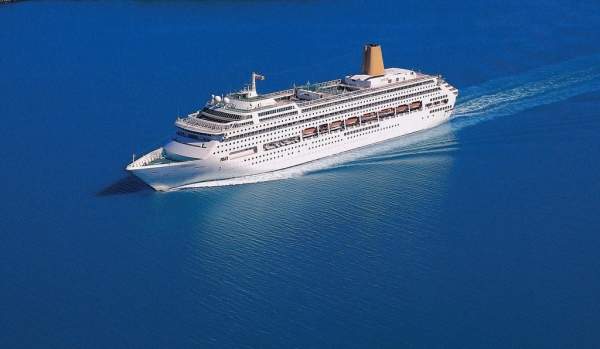
Oriana is the first cruise ship commissioned for P&O Cruises. Built by Meyer Werft, the vessel entered service in April 1995 as the first cruise ship designed for the British cruise market.
Oriana was constructed at Meyer Werft’s shipyard located in Papenburg, Germany. It was launched in June 1994. The cruise ship commenced her maiden voyage from Southampton on 9 April 1995.
Recommended White Papers
Industrial and Marine Boiler Services
Boiler maintenance services for the marine industry, recommended buyers guides.
Leading robotics companies in the shipping industry
Bunker fuels, lubricants and fluids for the shipping industry.
Oriana underwent a £12m refit in December 2006. The ship was upgraded with the new Oriana Rhodes restaurant. The Lord’s Tavern bar was expanded. The staterooms were restyled with new colour schemes and interiors. Oriana was also re-registered from Britain to Bermuda in the same year to host weddings at sea.
The 69,000grt cruise ship has an overall length of 261m, beam of 32.2m and a draft of 8.2m. Oriana can complement a crew of 800. The maximum passenger capacity of the ship is 1,928.
Oriana cruise ship refurbishment
Oriana entered the dry-dock for a multimillion pound makeover in November 2011. The one month-long refurbishment transformed the ship into an ‘adult-only’ vessel. Oriana was given an additional 27 new cabins on deck eight aft and the Ocean Grill restaurant.
The refit also resulted in a second restaurant, Sorrento, with an outdoor dining area. The aft deck and its bar saw design changes and décor in the public areas and Oasis Spa was revamped.
The Mediterranean-style café, Al Fresco, has been reinvigorated with new looks. The completely refurbished Pacific Lounge received new seating and carpeting, as well as new hand rails to the seating rows.
The new lighting and multimedia equipment have been installed in the Theatre Royal. The Low Carbon Leather supplied by Andrew Muirhead & Son and the Bridge of Weir Leather Company was used in the makeover of leather interiors.
P&O Cruises’ Oriana facilities
The refurbished cruise ship offers 909 passenger cabins located over ten decks. The room categories available include: inside cabin, outside cabin, deluxe balcony cabin, suite and mini-suite.
All rooms are provided with a TV, radio and telephone, hair-dryer, refrigerator, a safe, tea / coffee makers, air conditioning, writing desk and chair, wardrobe and drawer space.
The Peninsular and Oriental are the two main dining venues located on the E deck. Each dining venue offers seating for more than 500 guests. Ocean Grill serves modern British cuisine with a wide range of menu options. The Sorrento is an Italian restaurant offering pizza, pasta and seafood. The Lido Deck has the Al Fresco Pizzeria, Terrace Grill and The Conservatory restaurants.
The D deck features Chaplin’s Cinema and the Terrace Pool. The Pacific Lounge hosts cabaret acts and is also used as a lecture room. Entertainment venues, such as the Theatre Royal, Harlequin’s bar and nightclub, Knightsbridge, Monte Carlo Club casino and Anderson’s bar, are located on the Promenade Deck.
The Sun Deck provides plenty of space to accommodate pools, sports court and golf nets. The Oasis Spa and salon offers new thermal lounges and a dedicated aerobics floor. Other facilities include a steam room and treatment rooms.
Propulsion of P&O’s improved cruise ship
Oriana is powered by four MAN B&W L58/64 diesel engines driving two controllable pitch propellers through two Renk-Tacke gearboxes. The gear boxes are coupled to engines via Vulkan-Rato couplings. The engines deliver a combined power of 37,750kW.
The propulsion system also integrates three bow thrusters, one stern thruster and two rudders.
The cruise ship is installed with stabilisers to reduce the rolling motion by 90% at a speed of 19kt. The shipboard power is provided by four MAN B&W 6L40/54 auxiliary diesel generator sets. The propulsion system provides a service speed of 24kt.
Related Projects
More Projects
Villa Vie Odyssey, UK
Celebrity ascent cruise ship, usa, adora magic city cruise ship, china, superyacht luminara, france, sign up for our daily news round-up.
Give your business an edge with our leading industry insights.
Sign up to the newsletter
Your corporate email address.
Ship Technology In Brief
Ship Technology Global
I consent to Verdict Media Limited collecting my details provided via this form in accordance with Privacy Policy
Thank you for subscribing
View all newsletters from across the GlobalData Media network.
Cruise Ship Odyssey
Ss oriana (1960) – orient line.
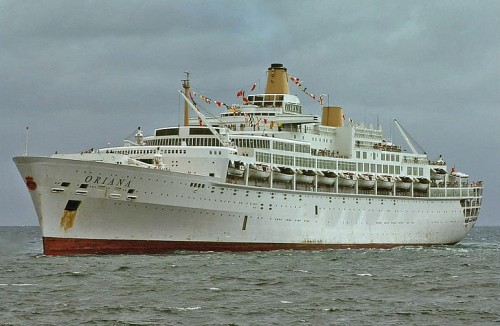
- June 23, 2023
In 1957 Orient Line (short for Orient Steam Navigation Company) ordered a new flagship, their largest yet. Like more passenger ships built at the time, she was designed with both liner service and cruising in mind. Her building price was 14 million pounds. During the design phase, her intended name was Orbustus . Her superstructure was built in aluminium, her keel was laid on September 18, 1957 at the Vickers-Armstrong yard and at the time she was the largest passenger ship built in England. She was designed by Orient Line’s Charles F. Morris, one of thier leading naval architects. Capable of 27 knots she was a fast ship. The fastest ship of the P&O-fleet was awarded the Golden Cockerel and Oriana as the ship was ultimately named, retained it until she was withdrawn and it was passed on to the Canberra , which had always been te slower of the two.

Orient Lines had been thinking of building a vessel of around 28,000GRT with a speed of 22.5 knots or ordering a much faster ship that could make 27 knots. This would reduce a round trip England – Australia -New Zealand by about a fortnight, thus saving more than enough operating costs to justify the extra building costs.

HRH Princes Alexandra launched her in November 1959 and named her Oriana , meaning Dawn in latin. Oriana was also a reference to Queen Elizabeth I’s nickname. Further outfitting and trials during which she reached a maximum speed of 30.64 knots followed. Finally, in December 1960 she left Southampton on her maiden voyage to Australia. It took her 24 days to reach Melbourne. Until Canberra was introduced she was the largest vessel on the route. A year later she did 27 knots after departing Auckland for Sydney and set a new record. When she passed through the Panama Canal in July 1961, she was the largest vessel since the ss Bremen in 1938 to do so. In 1962 she collided in dense fog with the US air carrier USS Kearsarge and both ships suffered hull damage. It led to a fight in court to establish which ship was at fault. Two years later in 1964 again a record was set between Auckland and Sidney, she reached 27.76 knots. Oriana was transferred to P&O Lines after the merger (P&O and Orient Line had meged in 1960) and her corn coloured hull was repainted to white.

Unfortunately in 1969 Oriana suffered some damage when she struck a wall of one of the Panama Canal locks and she damaged one of her propellors. A year later again problems arose when a fire broke out in the boiler room just after leaving Southampton for yet another voyage down-under. She was towed back and repaired in two weeks. Starting in 1973, her capacity was changed to 1677 passengers in one class and she switched to full time cruising from November to January out of Sydney and the remainder of the year from Southampton.

In 1978 an anonymous letter was received at P&O headquarters with the message that a bomb had been placed onboard Oriana . A bomb squad was sent out to the ship, but the crew had already conducted a thorough search and nothing was found so they could return home. In 1981 P&O decided to withdraw Sea Princess from South Pacific cruise service out of Sydney and Oriana replaced her. Four years later P&O announced Oriana would be witdrawn from service too and in March 1986 she was laid up in Sydney at no.21 Pyrmont Wharf. Just two months later she was refitted st the Hitachi Zosen yard for a stationary role as a museum, hotel and tourist centre, having been sold to Japanese interests. Her propellors and rudder were removed and in August that year she was moored at Oita, near Beppu, a resort on the island of Kyushu, Japan. Her funnels were painted pink.

The Chinese Hangzhou Jiebai Group, owner of a chain of department stores bought her in 1995 and she was relocated to Qinhuangdao in China for use as a floating hotel. Three years passed by and again a change of ownership, now she was sold to Hangzhou West Lake Int. Tourisme Cultural Delopment Co. for $6 mio. and towed to Shanghai. There she was again refitted and new elevators and airconditioning was installed. She was advertised as “maintaining her British style, keeping original furniture and artefacts in place”. Almost $4 mio.was spent on upgrading her and she opened February 1999 as a floating hotel complete with a swimming pool, wedding chapel, miniature golf course and a 20,000 sq m exhibition hall. Now located on the Huangpu River at Shanghai, 3000 visitors board her daily. A year later, Oriana had received half a million visitors but her owners stated she had made a loss of a quarter of a million dollars….

In 2001 reports were confirmed that she was sold yet again, this time for $4 mio. Again she would be refitted prior to her new role as a museum, banquet hall and theme aprk in the Chines port of Dalian. The Huanghzou Sonhcheng Group is said to have invested $400,000 in refitting the ship in 2001 after they had acquired her. The only original parts of Oriana now still remaining are the bridge, post-office, VIP-hall , hospital and some spaces that had been turned into a museum. Alas in 2004, one of the worst storms to have ever hit the region severely damages Oriana and she heels over, partly submerged. Being too heavily damaged to be repaired, in June 2005 four tugs delivered her to a Chinese scrapyard.
In 1995 P&O honoured Oriana of 1960, the last Orient Line liner, by naming their new cruise ship, replacement for the Canberra, Oriana .

Recent Posts

Johann Georg Poppe (1837 – 1915)
He brought international flair to

John McNeece (1939 – 2015)
Designer who specialised in creating
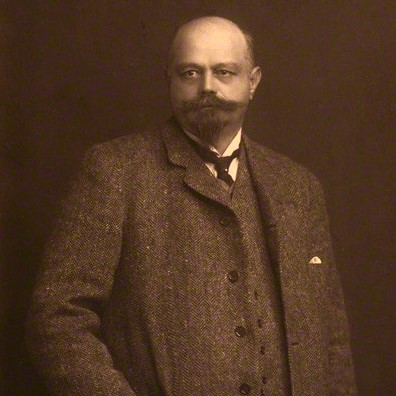
Charles Frederic Mewès (1858 – 1914)
He introduced hotel-style interiors to

Joe Farcus is one of
- Cruise ship interiors
- Out of service
- Static ships
- Annual news review
- Ships on order
© 2003-2023 Cruise ship Odyssey, Paul Timmerman. All text and photographs (unless stated otherwise). All Rights Reserved.
Copyright disclaimer.
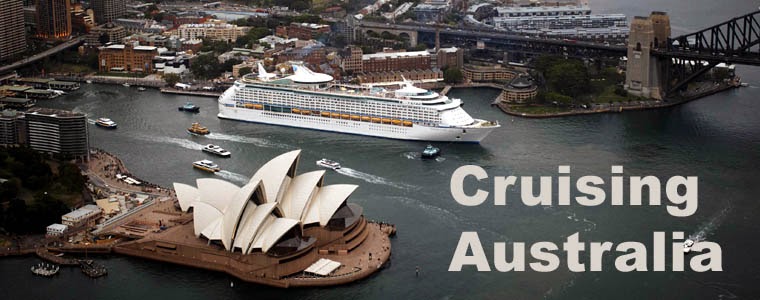
- Cruise Ship and Maritime Postcards
Get Cruising!
Tuesday 23 December 2014
History of p&o oriana.
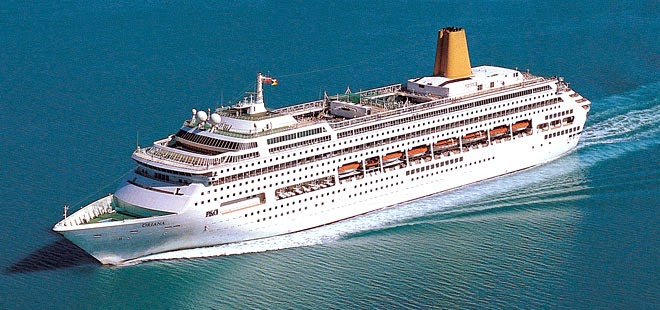
No comments:
Post a comment.
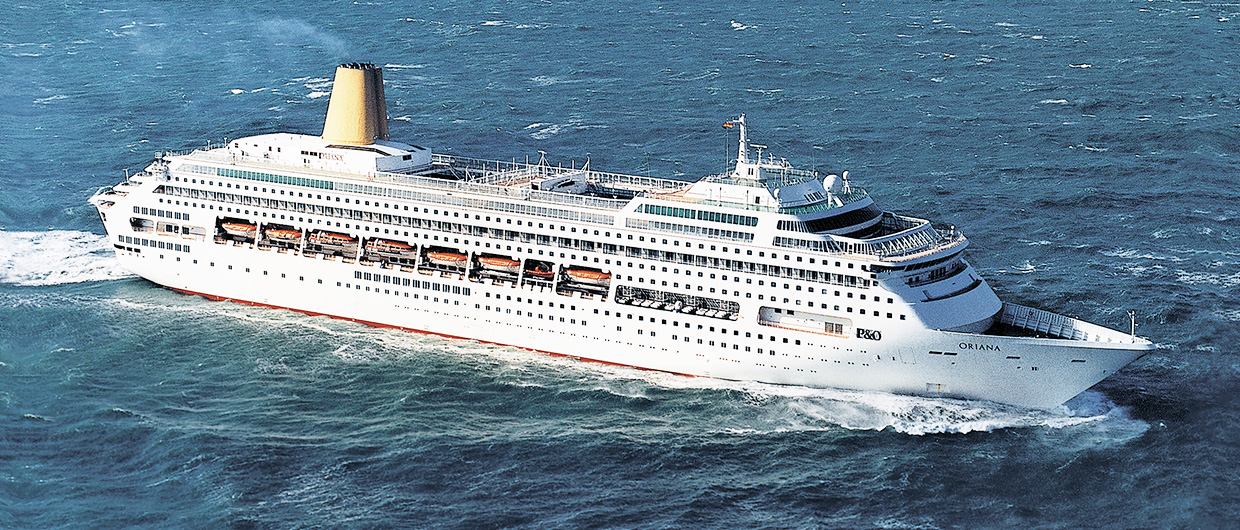
Oriana’s interior design is reminiscent of English country houses of centuries gone by, while its elegant exterior features a sleek design and white hull. It also has a lot to offer from a technical perspective, cruising through the oceans at an impressive rate of 24 knots. The sheer depth of the vessel ensures incredibly peaceful cruising. When Oriana left the MEYER WERFT docks, it was the most modern cruise ship of its era.
Oriana was delivered to P&O Cruises in 1995, measuring 260 metres in length and featuring 914 staterooms – it was the largest passenger ship that had ever been built in Germany. The cruise liner was the predecessor of Aurora, which MEYER WERFT delivered to P&O Cruises in 2000.
Oriana’s theatre extends over three decks, featuring an orchestra pit, stage lift and revolving stage. With a cinema, ballroom, casino and library, Oriana’s passengers really are spoiled for choice. They can also enjoy a game of tennis or a relaxing session in the luxurious spa. The ship’s hub is the atrium, which extends over four decks and features an eye-catching 12-metre waterfall.
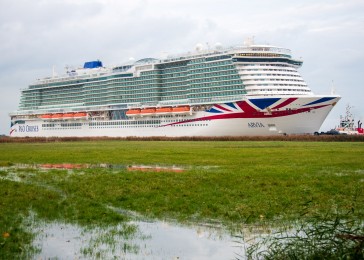
Cruise Ship Oriana

Cruises On Oriana
ms Oriana Cruise Ship Profile
Ship features, itinerary, news, photos, review, accommodations, notable rooms, dining venues, kid's areas, deck plan, outdoor spaces, smoking sections.
- Tropical Weather
- Destinations
- Ship Safety
- Sudden Lists
- Sunken Ships
- Natural Hazards
- Travel Warnings
- Cruising QA
- Nautical Terms
- Alaska/Canada Maps
- Bermuda Maps
- Canada/NE Maps
- Caribbean Maps
- Europe Maps
- Mediterranean Maps
CDC Ship Outbreak Summary
Get to know our slice of Paradise - located on the SW Coast of Fl.
Attractions Beaches Canoe/Kayak Boat Launches Boat Charters Fishing Charter Fishing Piers Historical Sites Golf Parks Hotels Relocate Venice Map
P&O Links
P&o fleet.
Back to the top
CDC Sanitation Ratings
2013 Rating 92 (Mar) 2011 Rating 95 (Oct) 2010 Rating 100 (Oct) 2010 Rating 97 (Mar)
The Oriana takes passengers on trips about the Mediterranean, the Canary Islands, and the Fjords & Iceland.
Please visit the P&O website for complete listings.
Sports Deck, Crow's Nest, Medina Room
The Conversatory, Terrace Bar, Sorrento, Crystal Pool, Riviera Pool, Oasis Spa & Salon, Gymnasium, Tennis
Passenger Staterooms
Terrace Pool, Sunset Bar, Chaplin's Cinema, Crichton's, Library, Ocean's Grill, Tiffany Court, Passenger Staterooms
Oriental & Peninsular Restaurants, Knightsbridge, Queen's Court, Passenger Staterooms
Promenade Deck
Pacific Lounge, Lord's Tavern, Harlequins, Andersons, Knightsbridge, Theatre Royal
Medical Center
ships > P&O > Oriana
Exclusively for adults, the Oriana prides it itself on its luxurious accommodations and options. Signature ship features include a Tiffany glass ceiling in the Atrium and the panoramic Crow's Nest. Attend the black tie soireé as the sun sets over the sea or relax on the poolside sun deck.
Webcam and tracking link
Specifications
Launched: 1994
Registry: Bermuda
Refurbished:
GRT: 69,153 ft.
Length: 853 ft.
Draught: 26 ft.
Speed: 26.2 knots
Passengers: 1,928
Accommodations
Standard amenities.
Daily steward service, TV, radio and telephone, hairdryer, refrigerator and safe, tea/coffee making facilities, air conditioning, picture window* (outside cabins) or picture mirror* (inside cabins), vanity/writing desk and chair, wardrobe and drawer space.
Stateroom sizes
Additional Suite amenities:
• Two lower beds convertible to a king-size bed • Bathroom with shower over full-size whirlpool bath and WC • Separate guest WC • Iron, ironing board and trouser press • Lounge area with sofa, table and chairs • Additional TV DVD player • Mini stereo • Floor to ceiling sliding glass doors leading to balcony with table and chairs, steamers and footstool
Special touches: Butler service (inclusive but optional), Mineral water on arrival, Luxurious premier pamper pack, Coffee machine, Bathrobe and slippers, Magazine and newspaper selection, Atlas and binoculars, Fruit basket, flowers, champagne and chocolates on arrival, Daily canapés.
Dining Venues
$=Specialty dining, surcharge applies
Peninsular & Oriental Restaurants
Main dining with formal seating serving a five-course menu nightly. The restaurant blends international and British cuisines.
A casual eatery on the Lido Deck. Pop in for a light snack from late morning until early evening. Serving pizza, burgers, salads, and sandwiches.
The Conservatory
An informal, self-service buffet for any meal of the day, including afternoon tea. Relax next to floor-to-ceiling windows while enjoying cuisine from around the world. In the evening, the venue transforms into Le Jardin, an informal eatery.
The Ocean Grill ($)
Inspired by Chef Marco Pierre White, Ocean Grille offers aged steaks and other al fresco dishes expected to a high class grill restaurant.
Sorrento ($)
Fine Italian dining restaurant serving classic dishes like leek risotto with taleggio cheese.
Notable Rooms
Theatre royal.
Watch evening musical extravaganzas in superb style with a West End sparkle. The decor was inspired by the Tudor period and is bedecked with rich colors.
The Crow's Nest
Enjoy a panoramic views of the seas in a relaxing, pre- or post- dinner lounge with live piano music.
A superb dance venue with the latest in sound equipment. The wooden-sprung dance floor is perfect for ballroom dancing.
Chaplin's Cinema
Enjoy the latest blockbusters or your favourite old classics, which are shown throughout the day and evening. Chaplin's is also used for lectures, port enhancement talks, and much more.
Lord's Tavern
A tribute to the world-famous Lord's Cricket Ground, this quintessential British sports bar is adorned in cricket memorabilia.
YOUR GUIDE TO CRUISING
- Ships Index
- CDC Ratings
- Cruise Ship Webcams
- Embarkation
- Caribbean Beaches
- Clothing Optional
- Destination Webcams
- Canada/Alaska
- Mediterranean

Where Is the Cruise Ship Oriana Now?
By Anna Duncan
The Oriana is a popular cruise ship owned by the P&O Cruises company that has been sailing since 1995. It has been a beloved part of the P&O fleet for over two decades, and was last seen in port in the United Kingdom. The Oriana has had many different ports of call, including some of the most exciting cities and locations around the world.
The Oriana underwent a major renovation in late 2018 and was updated with modern amenities such as larger cabins, improved dining options, a spa, and an open-air pool. This was part of P&O’s effort to continue to provide guests with great experiences on board their vessels.
The Oriana is currently sailing around Europe with destinations including France, Spain, Italy, Portugal, Croatia, and more. It is also set to make its way to South America later this year for more exciting ports of call. This makes it one of the most diverse ships in the P&O fleet.
Onboard activities on the Oriana include live performances from singers and musicians as well as various onboard activities like cooking classes and wine tastings. There are also multiple bars and lounges where guests can relax while enjoying drinks or light snacks. The ship also features a casino where guests can try their luck at various games.
The Oriana also offers a variety of shore excursions which are designed to give passengers an opportunity to explore each port more thoroughly. These excursions range from sightseeing tours to cultural experiences such as visiting historic sites or tasting local cuisine.
7 Related Question Answers Found
Where is the artania cruise ship now, where is artania cruise ship now, where is the cruise ship aurora now, where is the aurora cruise ship today, where is the marella cruise ship now, where is the artemis cruise ship now, where is epic cruise ship now, backpacking - budget travel - business travel - cruise ship - vacation - tourism - resort - cruise - road trip - destination wedding - tourist destination - best places, london - madrid - paris - prague - dubai - barcelona - rome.
© 2024 LuxuryTraveldiva
- Search Search Search …
- Search Search …
1960 – 2005
Looking back at the 20th century, the 1940s must be the one filled with most contrasts. The first half, from 1940 to 1945, was a time of great conflict, with the Second World War raging across the globe. This was a war of total destruction, and when peace was finally achieved in 1945, the tolls had been catastrophic. In terms of human lives, millions had perished, either in battle or through the cruelties of concentration camps. Materially, both sides had suffered immensely. Entire nations in Europe had been furiously bombed, and were by now severely crippled.
On the maritime side, things were not much better. A great number of merchant ships had been lost in the war, falling victims to torpedoes, bombs, mines or even scuttled by their own crews. Now that the world was ready to rebuild, ships were needed to get the commerce up and running again. But with resources close to depleted and a massive labour shortage, building new tonnage was easier said than done.
Fortunately, there was help available. During the second half of the decade, with the aid of the Marshall-plan, Europe was able to turn destruction into recuperation and rise to its feet again. With prospects of better times to come, the shipping companies now started looking into the possibility of commissioning new ships. One of these companies was Britain’s Orient Line, which was one of the dominants on the Australasian run. Starting in 1948, Orient Line put three new 28,000-ton ships into service over a period of six years. The Orcades came first, followed by Oronsay in 1951 and the trio was completed with the Orsova in 1954. These ships were clearly built for the post-war world, since their passenger accommodation was divided into two classes only; First and Tourist. They also sported a very modern appearance, with a single funnel perched atop a stepped-up superstructure. The novelties were taken one step further with the third ship – Orsova– which became the first major liner to dispense with the traditional mast entirely. All necessary rigging was instead attached to the funnel.
So, in the 1950s, this trio headed the Orient Line fleet, which also included some older World War II survivors like the Orontes of 1929 and the Orion, which had entered service back in 1935. And the future looked promising, indeed. While the more glamorous North Atlantic service was being subjected to the grim aeroplane competition, the Australasian route was booming. The reason to this was emigration, just as it once had been on the transatlantic run.
While things had certainly improved in Europe since the armistice, there were still millions of Europeans who were tired of the post-war austerity. So, just like many of their countrymen before them, they were now seeking a new life in a new country. But the United States were no longer the most common destination. Now, Canada, South Africa, Australia and New Zealand became the popular destination. Australia, which saw the opportunity to increase its population, even went as far as to introducing a unique government-assisted passage scheme. For just £10, one could purchase a ticket to a new life and a fresh start. But to get there, you had to travel halfway around the world.
And so, in the mid-1950s, with these prospects in mind, the Orient Line began planning for a new ship for their Britain-Australia run. However, there were many questions to be answered about the specifications of the future liner. The main issue was if they should go for a fourth sister of the Orcades-class, or set out to build something larger and faster.
It was not an easy decision to make. Orient Line approached the Barrow shipbuilding yards of Vickers-Armstrongs and asked them to investigate the matter, and after having gone over the aspects of fuel consumption, maintenance, staff costs etc, it became apparent that a large and fast ship was the best option. By offering a faster round trip, the ship would in it self make up for the higher costs of operating such a large and fast vessel. With the decision made, a contract was signed with the Barrow yard to build the new liner. A further two years was spent pondering and refining the blueprints, until the first keel plate on the yard’s number 1061 was laid on September 18th 1957. With work now underway, it would still take more than two years before the new liner could be launched.
Then, on November 3rd 1959, the day of launch had finally arrived. It was a festive occasion, since this was the yard’s largest ship ever and, at the time, the largest yet built in England. Her Royal Highness Princess Alexandra had agreed to christen the new liner, and by pulling a handle she released the bottle of champagne which then crashed onto the ship’s bows. The name she gave the new liner – Oriana – was a name with many meanings. For one thing, it was a reference to the Elizabethan name used for Queen Elizabeth I who was in poetry called ‘Gloriana’. There was also the derivation of the name, which in ancient Greek means ‘East’ and in Latin ‘Dawn’. Then of course, it began with ‘O’ – conforming to the Orient Line’s traditional nomenclature.
When the classic ceremony had been performed, the massive hull started moving and slid down the ways into her proper element. The Orient Line house flag hoisted on her superstructure fluttered in the wind, and the powerful moment was accompanied by ‘Fanfare for Oriana’, specially composed for the occasion by Sir Benjamin Britten himself. Once the massive hull had been brought to a halt, it was then berthed at the fitting-out quay in Buccleuch Dock. Here, the still uncompleted Oriana would go through her metamorphosis to become a grand Orient liner.
As work progressed, Oriana came nearer to completion by the day. But as the ship’s appearance changed, so did circumstances around her. On May 2nd 1960, P&O and Orient Line went together and pooled their passenger ships in the same subsidiary company, which became known as the P&O-Orient Lines. It was however agreed that the two companies would retain their separate house flags and liveries. Indeed, P&O already owned a large share of the Orient Line, which it had obtained already in 1919.
Six months later, on November 13th 1960, the Oriana had been completed and was now to go through her sea trials. These were carried out on the Clyde, and were most satisfactory. Oriana had been built for speed, and her two sets of Pametrada geared turbines did not fail to deliver. In adverse weather conditions, the ship managed to reach a top speed of 30.64 knots. Since she had been designed for a service speed of 27.5 knots, these results were indeed pleasing to the company board. So, some five years after the original decision, Oriana was now finally ready to enter service as the new Orient Line flagship. After having taken on provisions, she left Southampton on her maiden voyage on December 3rd 1960, bound for Australia. This was a divergence for the Orient Line, whose ships had earlier sailed from London. The tradition was partially maintained though, as London was Oriana’s official port of registry, as could be read on her stern.
The port of Southampton had witnessed many maiden departures in its days, but surely none of such a peculiar-looking ship. Oriana had come out of the shipyard with a most unusual profile, and there were in fact a number of people who looked upon her as plain unattractive. Following the Orient Line trend set by the Orsova in 1954, she had no conventional mast but only a short radar mast. The bridge was situated almost amidships, crowning the welded aluminium superstructure’s series of terraced decks and the long, graceful bow. Her lifeboats were carried in special lifeboat bays in the hull, with several full-width decks above them. But the most odd feature must have been the two funnels. According to some, they looked like flowerpots stood upside-down. Differing slightly in design, the aft funnel was a dummy and was situated in a lower position than its forward counterpart. Oriana had also been built with bow and stern thrusters, making her more easy to manoeuvre.
But although there were many novelties that might have been hard to embrace at first, there were also many appealing features. Being an Orient liner, Oriana sported the wonderful corn-coloured hull of the company. The bow was adorned by a special bow decoration, consisting of two entwined ‘E’s’, representing two Elizabethan eras – the Tudor one after which she was named, and the Windsor one in which she was built. The ship’s name was spelled out in what must be some of the largest letters ever put on a ship and internally, she had been designed both for the Australian run as well as the growing cruise market. Her accommodation was divided into a First and a Tourist Class, with many comfortable public rooms at their disposal. The restaurants, the Princess Lounge, the Red Carpet Room and the Silver Grill to mention a few, they were all done in a typical 1950s style – elegant and functional, as opposed to gaudy and glitzy. In addition, every cabin was equipped with a radio – grand luxury in 1960!
Sailing via Suez, Oriana arrived at Melbourne for the first time on December 27th and in Sydney three days later, on the 30th. There she celebrated the New Year’s, and departed on January 5th 1961 from the new International Terminal at Circular Quay on a pleasure cruise to Auckland, Vancouver, some American West Coast ports and back to Southampton. During these premiere voyages, Oriana was warmly appreciated in spite of her unconventional looks. Upon her first visit to San Francisco on February 5th, the city council announced that the day henceforth would be known as Oriana Day.
She then set course back to Sydney, and was back in Southampton on March 25th 1961. Her owners could now summarise the successful maiden voyage. Not only was she the largest Orient liner ever, but she was also the largest ship operating in the Pacific Ocean. In addition, Oriana’s speed had certainly not disappointed. The passage from Southampton to Sydney via the Suez Canal had earlier been measured in about a month, but Oriana had completed the stretch in 21 days flat. The following June, she again set a new speed record when she sailed from Auckland to Sydney with an average speed of 27 knots – the fastest trans-Tasmanian sailing so far. In the month that followed, on July 31st 1961, she passed through the Panama Canal for the very first time on a return voyage to Southampton and again setting a record of sorts – she was the largest liner to transit the canal since Norddeutscher Lloyd’s Bremen in 1938.
However, in the midst of all this success, Oriana soon suffered her share of misfortune. On December 3rd 1962, while sailing in dense fog just off Long Beach, California, she collided with the veteran USS aircraft carrier Kearsarge. The Kearsarge’s aft starboard side was penetrated, resulting in a 25-foot gash. Oriana on the other hand, also received damages. A 20-foot hole was torn up near the bow, and a small fire broke out in her boiler room. This was quickly extinguished however, and luckily the incident did not result in any fatalities. When the damages had been assessed, Oriana was taken into Los Angeles for repairs.
The years that followed were much happier for the Oriana. On September 17th 1963, Sydney’s Mayor Henry Frederick Jensen presented the keys of the city to Oriana’s master during a ceremony held at Circular Quay. And being the speed queen that she was, Oriana set yet another speed record in 1964 when she completed the passage between Auckland and Sydney in 45 hours and 24 minutes at an average speed of 27.76 knots. But there were great changes waiting in the future. In 1965, P&O acquired the remaining shares of the Orient Line, and all the Orient ships were transferred to P&O registry. With this, Oriana lost her lovely corn colour, as she was repainted in P&O white. In October of 1966, the name P&O-Orient Lines was dropped, and restyled to just P&O. With that, the Orient Line passed into history.
Nevertheless, Oriana steamed on, still being a very stately lady. But in 1969, she again suffered bad luck when she was transiting the Panama Canal. While manoeuvring the ship through the tight locks of the canal, the ship struck the side of the basin and severely damaged one of her two propellers. Although repairs were carried out, it has been said that one of the ship’s drive shafts was so badly misaligned in the accident that she never again was able to reach her top speed of 30 knots.
The misfortunes seemed to continue into the next decade. In August of 1970, Oriana left Southampton on yet another routine voyage to Australia and New Zealand. But shortly afterwards, while the ship was still in Southampton waters, a fire broke out in the boiler room switchboard. The damage caused Oriana to lose all power, and had to be towed back into port. She now had to spend two weeks out of service while repairs were carried out, but at least the company could happily report that no one had been seriously injured in the fire.
When Oriana returned to service, her future deployment was not at all certain. As on the North Atlantic in the ‘50s and ‘60s, air traffic was now becoming a serious competitor on the Australasian route. It soon became apparent that Oriana, which had been built with occasional cruising in mind, soon would have to earn her living by doing pleasure cruises full-time. In 1973, her passenger accommodation was altered to cater for 1,677 passengers in one single class. From now on, Oriana’s deployment would be cruising, nine months out of Southampton and for three months from November based at Sydney, with positioning voyages via Panama in each direction.
Luckily, this did not mean bad times for Oriana. Since she was very much suitable for doing cruises, she continued to turn a profit in spite the fact that line voyages had been more or less abandoned. The task of cruising did not hinder the ship from seeing further dramatic events, though. In May of 1978, while Oriana was on a Caribbean cruise, the P&O headquarters received an anonymous letter when the ship was three days out of Southampton. The letter was an ominous one, warning that a bomb had been placed on board the ship. A bomb disposal squad was flown out to rendezvous with the ship, but upon their arrival a thorough search of the ship had revealed nothing. The whole thing was obviously just a hoax, and the bomb squad was never required to parachute on board.
A few years later, the Oriana’s long-time acquaintance with the port of Southampton ended in 1981, when she became permanently based at Sydney for South Pacific cruising. However, this service was only to last for another few years. In 1985, P&O announced that Oriana would be taken out of service and sold out of the fleet the following year. On March 27th 1986, she completed her final cruise for P&O and was then laid up at Sydney, awaiting her future. As a working ship, she had steamed 3,430,902 nautical miles and she had visited 108 ports over her illustrious career.
Two months later, on May 21st, the ship was sold to the Japanese company Daiwa House Sales. Their intention was to transform Oriana for use as a hotel, museum and leisure centre. One week after the sale, Oriana left Sydney bound for the Hitachi Zosen shipyard where she was to go through the conversion. Since she was to be used in a static role, the ship’s rudder and propellers were removed and placed on the fore deck by the old crew’s swimming pool. On August 1st 1986, Oriana was moored at Oita, near Beppu, a resort on the Japanese island of Kyushu. By now, her funnels had been painted pink and the ship had been secured to the wharf by means of welding. She would stay there for another nine years.
By mid-1995, the Daiwa House venture had collapsed, and the ship was sold to the Hangzhou Jiebai Group Co. Ltd., a Chinese department store operator. Oriana was loosened from her welded moorings and towed to Qinhuangdao in north China, where she was put to use as an accommodation centre and hotel. Sadly, she was not maintained very well, and soon fell into deep disrepair. In November of 1998, she was again sold, this time to the Hangzhou West Lake International Tourism Culture Development Co. Ltd., for the price of US$6,000,000. On November 15th, five tugboats towed Oriana from the port of Qinhuangdao to Shanghai.
As the ship was now in very poor condition, she was given an extensive overhaul, which included alarm systems, new elevators and climate control. It was announced that the ship would maintain “the traditional British style and elegance of its earlier years”. On February 16th 1999, the ship was once again opened to the public. After a US$3,630,000 refit, the ship included features such as hotel accommodation, a swimming pool, a miniature golf course, a 20,000 m2 exhibition hall and a wedding altar on the ship’s bow, inspired from the famous ‘bow-scene’ from James Cameron’s movie ‘Titanic’. At first, the project was highly successful, with a daily average of 3,000 visitors. Starting on December 24th, a nine-day millennium celebration was held on board, including theme dinners, symphony concerts, fashion shows, auctions, garden parties and buffets.
But this giant party turned out to be the peak just before a downhill. In July of 2000, it was reported that the liner had failed to generate the expected profits and she was shut down the following August. Once again, new owners were sought, and a public auction was held on September 28th. This time, the Song Dynasty Town Groups managed to acquire an 85% share of the ship for the price of US$7,250,000. They announced that the ship would once again be refurbished for static use, but many were, quite rightly, sceptical to those plans.
So from then on, Oriana sat in Shanghai, moored on the Huangpu River. During her time there, she was touted as the ‘Titanic of Huangpu River’, ‘the sister ship of Queen Elizabeth’, ‘a British Imperial Cruiser’ and ‘one of the four most famous luxury boats of the contemporary world’. Not much was recognisable from her glory days with the Orient Line and P&O, except for the bridge, which had not been altered much from its original layout. In many deck areas, the Asian climate had been hard on the old girl, where plywood planks have warped and crumbled. The ship’s library still remained more or less untouched, but unused and left to decay. The Lido Pool had been plated over, after having been utilised as a carp pond for a period of time.
But amazingly, her owners lived up to their promises, and showed that the thought of a refurbished Oriana was not just a pipe dream! Having been towed to the Chinese port of Dalian in the summer of 2002, the old ship went through a massive refit that transformed her into the main attraction of the Dalian Theme Park & Entertainment Center. Now boasting for instance a maritime museum and an 800-seat banquet hall & showroom, the Oriana quickly became a popular venue. Tours of the ship were offered, so that visitors could experience the engine room and the bridge first-hand. Things had really taken a turn for the better, but sadly, it was not to last. On June 16th, 2004, the Oriana was struck by a severe storm and was badly damaged. She took on a great deal of water due to her being holed at the bow, and as a result her lower decks were flooded, and the ship quickly took on a dangerous list to port. Attempts were made to right her and the owners even considered restoring her, but naturally the cost proved to be too great. And so, on May 13th 2005, the old Oriana departed and was towed to the Wayou scrap yard in Zhangiagang, China to be scrapped. Time had finally caught up with her, and just like so many other great ladies of the sea, she ended her days under the cutting-torch of the breakers, a sad shadow of what once was a magnificent vessel.
Specifications
- 804 feet (245.6 m) long
- 97.1 feet (29.7 m) wide
- 41,915 gross tons
- Six Pametrada geared turbines turning two propellers
- 27.5 knot service speed
- Passenger capacity of 2,134 people
You may also like
Leonardo da vinci.
1960 – 1980 / Commissioned as a replacement for the lost Andrea Doria, the Leonardo da Vinci could be described a refined version of an already successful design. Unfortunately, she was destroyed by fire in 1980 and was sent to the breakers.
Empress of Canada (III)
1961 – 2003 / Also known as Mardi Gras, Star of Texas, Lucky Star, and Apollon / Part of the revitalisation of the Canadian-Pacific fleet, the third Empress of Canada is arguably best remembered for becoming the first ship of the Carnival cruise fleet as the Mardi Gras.
1961 – 1997 / The ‘Great White Whale’ of the P&O Line, Canberra was one of the last great liners built in the British Isles. Serving in the Falklands War, she had a long and prosperous career that eventually ended at the shipbreakers.
France (III)
1962 – 2006 / Also known as Norway / Another French masterpiece, the third France was built at a time when ocean travel was dwindling. When facing an early retirement, she was instead bought and transformed into the cruise ship Norway that would revolutionise the industry and remain in service into the 21st century.
Leave a comment Cancel reply
Your email address will not be published. Required fields are marked *
This site uses Akismet to reduce spam. Learn how your comment data is processed .
6 thoughts on “ Oriana ”
- 6 Comments
I am trying to find a record of a trip I did on Oriana for Christmas 2018/jan 2019 from Sydney, Australia around the Indian Ocean. We had NYE in Singapore. Thank you
Wrong Oriana , I’m afraid. If your voyage took place in 2018/2019, it must have been on the successor, MV Oriana , built in 1995. You seem to have sailed on her towards the very last stretch of her service with P&O. Soon after that, she was sold to a Chinese operator and renamed Piano Land . More info here: https://en.wikipedia.org/wiki/MV_Piano_Land
My dad crashed the Oriana in 1962
I was a cadet on Oriana back then. Peter Ballantyne
I have such fond memories of working there as a photog from 1974 on. It really was a very happy ship. both for crew and pax.
are there any pictures of the damage done to her starboard prop i was one of the two fitters that work on her in the dry dock in southampton the tail shaft and prop was pulled out about 14ft and bent upwards we worked 21days none stop to do the repairs

Upgrade your browser to access this website
Shipping Today & Yesterday is a specialist magazine for the shipping enthusiast offering up-to-date information, topical and in-depth historical articles.
Click here to learn how to upgrade your web browser.
Swansong of a Modern British Cruise Ship
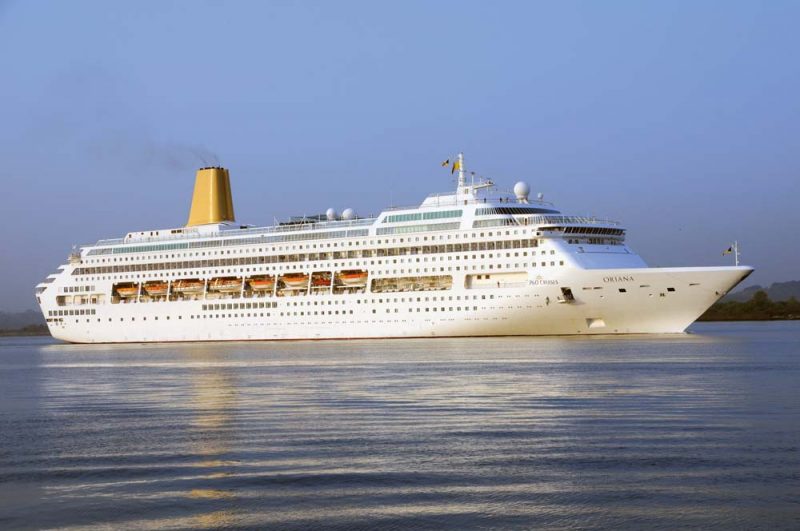
The announcement in July 2018 by P. & O. Cruises that their pivotal cruise ship Oriana, completed in Germany in 1995, would be retired in August 2019, as the company continued to modernise and expand it’s U.K. cruise programme, brought an end to 24 years of valiant worldwide cruising by the vessel. She was transferred during the same month by Carnival Cruises, the American parent company of P. & O. Cruises, from the ownership of P. & O. Cruises to a Carnival company with a view to using her in the growing Chinese cruise market for cruising the South China Sea to ports in neighbouring countries. Oriana was the first British purpose built cruise ship, and she has very much served as a benchmark for all the larger cruise ships that have followed her.
Design of Oriana
Oriana was the most traditional of the fleet of large megacruise ships owned by P. & O. Cruises, and carried 1,828 passengers on several hundred long and short cruises after she was specifically designed and purpose built for the U. K. cruise market. Robert Tillberg of Sweden and John McNeece of the U.K. were the two main designers of Oriana, and had spent a considerable time onboard the P. & O. cruise ship Canberra, completed in 1961, investigating the needs of British passengers, so as to include as many as possible of the features of Canberra into the design of Oriana. These features included an engines aft design to allow more passenger space, reduced engine noise, and with the engine fumes dissipated to the wake of the vessel.
It is worthwhile, as the design concepts of Oriana of 1995 are in many respects the same as the design of Canberra of 1961, to look at the life of the designer of the earlier cruise ship, John West. He was born on 13th August 1927 in Hebburn on Tyne and won a scholarship to Jarrow Grammar School and then studied naval architecture at King’s College in Newcastle. He joined P. & O. at the age of 25 years and two years later he became Assistant Manager in charge of technical and design work. He was promoted to be in overall charge of the design and supervision of newbuildings, with the order for the new cruise ship Canberra going to the Belfast yard of Harland and Wolff Ltd. The vessel was yard number 1621 and was launched on 16th March 1961 by Dame Patti Menzies, wife of the Australian High Commissioner in London. She cost a staggering £16 million in 1960 with the interiors of her public rooms designed by Sir Hugh Casson and hung with canvasses by a young artist named David Hockney. John West received many awards and medals for the design of Canberra and the many other ships he designed, and became a Visiting Professor to two English universities. He was a very committed Christian and lived long enough to see his beloved Canberra replaced by Oriana, and he died on 4th November 2003 at the age of 76 years.
Three interior designers for Oriana were engaged in Robert Tillberg of Sweden, John McNeece of London and Petter Yran. John McNeece and his team of designers gave the unique touches to rooms such as Anderson’s Lounge, the Knightsbridge shops, Harlequins disco and nightclub, the Pacific Lounge, the photo gallery, casino and related public spaces, as well as the onboard information graphics. Oriana has ten decks for passengers, four decks in her hull and six superstructure decks, with the Promenade Deck given an extra wide wrap around walking space, with her sixteen lifeboats being placed inboard on ‘D’ deck. The cruiser stern was tiered above to overlook the aft deck, pool and children’s play facilities. The elegant four deck high atrium and waterfall was topped by a dome of vibrant Tiffany glass, an Art Deco feature, and the central walkways leading to it gave good passenger flow. The base of the atrium consisted of a set of stairs flanked by two black painted elegant flower bouquet holders. The décor of her public walkways, shop fronts, and the corridors on each deck leading to the staterooms were restrained and conservative, and in no way ‘glitzy’.
Oriana obtained the high speed of 26.2 knots on trials with her service speed of 24.0 knots giving her the ability of keeping to schedule on long distance voyages to Australia, the destination of many of P. & O. liners of the past. Oriana holds the ‘Golden Cockerel’ trophy for the fastest ship in the P. & O. fleet, previously held by the Barrow built fleetmate of Canberra, the Oriana of 1960 with her twin ‘pepper pot’ funnels and a speed over the measured mile on trials of a fast 30.64 knots. The award passed to Canberra on the retirement of the first Oriana in 1986. The ‘Golden Cockerel’ was handed over to the new Oriana from Canberra when both ships were anchored off Cannes and each ship sent boats over to perform the handover ceremony. Oriana of 1960 had a very successful maiden voyage out to Australia after sailing from Southampton on 3rd December 1960. She then moved to the Transpacific service from Sydney (NSW) to Auckland and then under the Lion’s Gate Bridge at Vancouver before finishing at San Francisco.
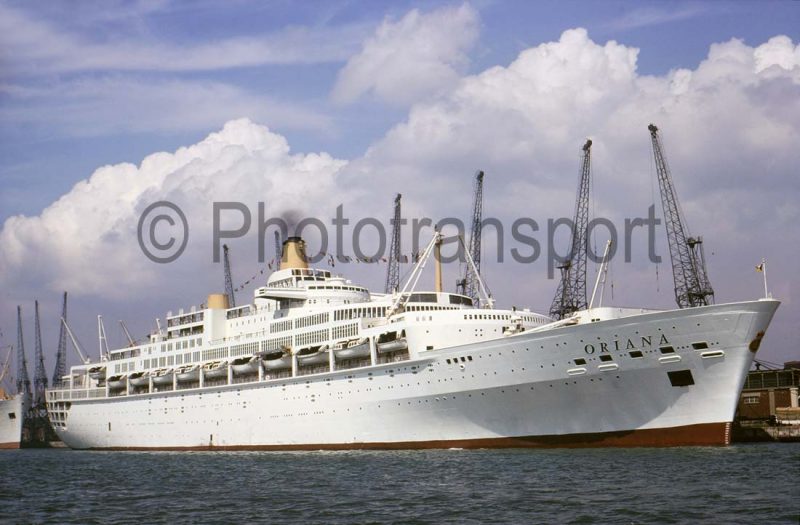
Oriana is powered by four M.A.N.-B & W L58/64 diesel engines of 47,750 kW combined capacity driving two controllable pitch propellers through two Renk-Tacke gearboxes. The gearboxes are coupled to engines via Vulkan-Rato couplings. The diesel engines comprise two nine cylinder centre engines and two six cylinder wing engines built at Augsburg with a total power of 54,040 bhp. This type of wing engine arrangement gives flexibility in the amount of power transferred through to the propellers, and thus control of fuel consumption. The propulsion system also integrates three bow thrusters, one stern thruster and two rudders. Oriana has very large stabilisers for the comfort of passengers, these covering a surface area of 21.5 square metres and reduce the rolling motion by 90% at a speed of nineteen knots. Two auxiliary steam boilers for heating and ancillary equipment use, four M.A.N.-B & W 6L40/54 generators to provide electrical power, and other pumps and equipment completed the engine room outfit, with compartments in the double bottom and alongside the engine room containing 2,400 tonnes of fuel oil bunkers.
P & O. would have wanted a British yard such as Harland and Wolff Ltd. of Belfast to build the ship, but fitting out such an important ship was problematic in a British yard, so the order went to the Meyer Werft yard at Papenburg in Lower Saxony in Germany. Construction in the large Building Hall was by a series of 500 tonne prefabricated sections, with her funnel and forward navigation mast fitted alongside the fitting out quay.
The single funnel was designed to look like the twin elegant funnels of Canberra, the basic design of both vessels being very similar with lifeboats being carried at the same deck level. She was laid down on 11th March 1993 and launched on 30th June 1994, making the slow two day passage down the river Ems to the sea when fitted out by March 1995. She was named by H. M. The Queen on 6th April 1995 at Ocean Dock in Southampton, and was towed stern first dressed overall with flags to the Western Docks two days later, passing Canberra, which was about to sail on a cruise and was also dressed overall with flags.
Oriana has an overall length of 853.02 feet (260.0 metres) with a moulded beam of 105.64 feet (32.2 metres) and a loaded draft of 25.92 feet (7.90 metres), and is equipped with forward and stern thrusters for manoeuvrability in port. Oriana was designed to have accommodation for 1,828 passengers on a cabin capacity basis of two passengers, with a total of 914 cabins (594 outside and 320 inside) with 112 single cabins, 118 balcony cabins on one deck, and eight cabins reserved for wheelchair passengers.
The Balcony Deck is on ‘B’ deck and comprises the most spacious and elegant Suites, Mini Suites and Deluxe Balcony staterooms sleeping up to four persons, with the other outside and inside staterooms normally for two person occupancy. The gross tonnage worked out at 69,153 with a net tonnage of 36,829, and she carries a crew of 794, with British officers and international stewards and dining staff. Oriana cost the expensive amount of over £200 million to build, and her name refers to Queen Elizabeth I, in the same way that Gloriana was used to refer to her in poetry.
Public Rooms of Oriana
The exemplary public rooms and facilities onboard comprise three outdoor swimming pools, the Oasis Health and Spa Club, a casino, three main Dining Room choices plus two speciality restaurants and two other dining options, and six entertainment choices, and other multi-purpose rooms. These are:-
Swimming and Health
Riviera Pool is situated forward on Lido Deck with the pool surrounded by a bandstand, two whirlpools, a bar and many sun loungers. A raised walkway above on Sun Deck extends around both sides of the ship for walking and jogging exercise.
Crystal Pool is further aft on Lido Deck, and at one end of the pool is a bronze sculpture by Andre Wallace of a man in a boat beside a reclining woman in another boat.
Terrace Pool is at the stern of the vessel on ‘D’ deck and has its own whirlpool. The open decks of Oriana feature a sports court, golf nets, shuffleboard and teak wooden promenades.
Oasis Health and Spa Club was originally run by Champneys and is located high on Lido Deck towards the bow of the vessel, offering massages, facials, and health and slimming treatment. The Spa also has a whirlpool, thermal chairs, steam rooms and saunas.
The Fitness Centre is within the Spa and runs exercise classes, personal training, with many exercise machines, free weights, treadmills, bicycle exercisers, and other equipment, with also an area for aerobics. The Salon is also in the Spa and offers hair styling, barber shop, make-up and manicures.
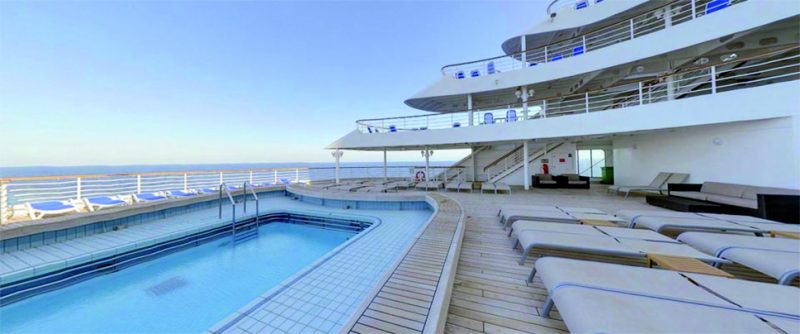
Entertainment
Theatre Royal with 664 seats is the largest entertainment venue with well known guest entertainers as well as productions by the ship’s own entertainers. The theatre was designed by John Wyckham and is decorated in rich red plush seats, curtains and fittings to give the feel of a West End theatre with high technology audio and lighting equipment to give good acoustics plus a revolving stage and orchestra pit. The seats are individually air conditioned to give guests a memorable experience in a very beautiful theatre.
Chaplin’s Cinema seats 189 and shows both classic and recent film releases, with the room also used for lectures and talks on Promenade Deck.
Harlequin’s Disco and Nightclub seats 230 has a very large dance floor for both daytime ballroom dancing and a late night disco dancing on Promenade Deck.
Pacific Lounge seats 430 and is located at the aft end of the Promenade Deck, and in the evenings hosts cabaret with stand-up comedians, magicians, British singers and acts, and musical performances. There is a full service bar, and it is also used during the daytime for a range of classes and activities.

Curzon Room named after Lord Curzon of India fame hosted classical music concerts and sessions for 140 guests, but was replaced in the 2006 refit at Bremerhaven costing £12 million of the ship by the new Oriana Rhodes restaurant for 96 diners designed by chef Gary Rhodes, after the success of the Arcadian Rhodes restaurant on her fleetmate Arcadia.
Oriana was re-registered at Bermuda at the time of the refit so that weddings could be held by her Master at sea.
Monte Carlo Casino is an intimate club style casino offering roulette, card and other games, with the gaming tables hosted by professional croupiers, and the room is also surrounded by slot machines.
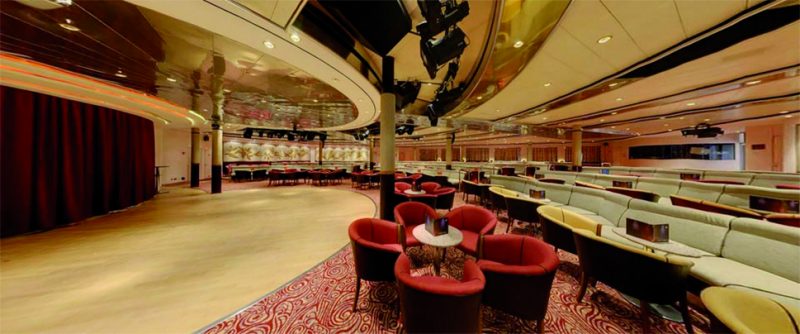
Peninsular Restaurant is ‘midships on ‘E’ deck and, as with the very similar Oriental Restaurant aft on the same deck, seats are allocated according to cabin grade and chosen cabin. It seats 524 and offers open seating breakfast, lunch and dinner, the latter being limited to passengers who have opted for P. & O. Cruises flexible dining system who can arrive at any time. There are tables for two, four, six and eight, with excellent decorated treatment of the ceilings, chandeliers and décor with Art Deco touches.
Oriental Restaurant is the same size as the Peninsular Restaurant but seats 454 and has fabulous views over the stern and wake of the vessel, with windows on three sides, and is usually open only for dinner with passengers assigned to a specific table according to cabin grade and chosen cabin for either the first or second sitting. The menu includes signature dishes by Anton Mosimann for this excellent and much recommended dining experience.
Conservatory Buffet Café is a self service buffet restaurant with plenty of natural light through full length windows on each side, and offers good panoramic views over the sea. It is open throughout the day and well into the evening as the third major restaurant on the ship, serving continental breakfasts, afternoon luncheons and snacks, to themed evening buffet dinners. The beverage stands are also self service but this does not detract for many passengers who enjoy a more casual ambience. Al Fresco Dining space is located forward of the Riviera Pool and offers self service Mediterranean outdoor dishes on its full menu.
Tiffany Court offers light snacks and pastries and is located next to the Tiffany glass ceiling of the magnificent atrium.
Sindhu Indian Restaurant is a speciality restaurant that was introduced after the ship had been in service for a number of years at the request of passengers who wanted a wider choice of food. The Indian cuisine was developed in co-operation with celebrity chef Atul Kochhar and is located ‘midships on ‘D’ deck near the atrium, with a cover charge payable on entering.
Beach House Buffet is another speciality restaurant in a section of the Conservatory Buffet Café for evening dining. This a very relaxed dining option offering a wide range of grilled meals and with panoramic views of the sea.
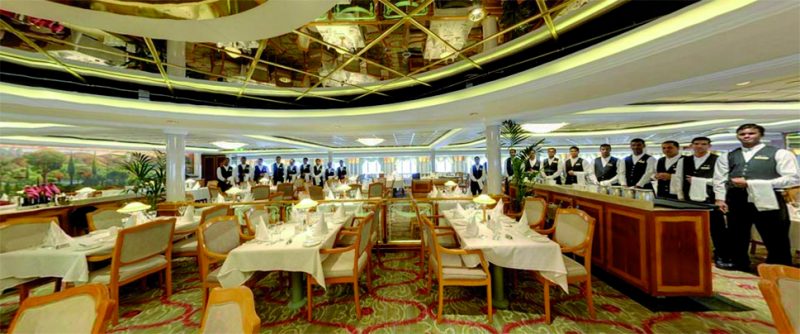
Shops, Children’s Rooms And Library
Knightsbridge Shops are located in a curved area and row on Promenade Deck near the atrium, and offer everything from expensive, high end jewellery to more modest priced fragrances, fridge magnets, duty free liquor and tobacco. The Photo Gallery is nearby, as is the Plaque Room where many plaques and treasured mementos have been placed after being gifted by Ambassadors and leaders of the many countries that Oriana has visited during the last 24 years.
The Library is a beautiful light brown wood panelled room with ten bookcases filled with hardback books, two reading tables, comfortable armchairs, reading lamps and a lectern, and was designed by Viscount Linley. There are also the usual bridge, chess, and backgammon for serious players of these games, and the cyber study has fast wi-fi and Internet access with again beautiful wooden armchairs. This room is a joy for all serious readers to while away a few hours on a long day at sea with no port calls.
Children’s Rooms include the Decibels teenage disco with very loud music, as well as indoor and outdoor facilities for the younger children. The rooms were refurbished during the 2006 refit, and then converted in 2011 to cabins during her transformation to an adult only cruise ship.
Multi-Purpose Rooms
Thackeray Writing Room is a traditional writing room lit by lamps on each table and with relaxing furniture and armchairs, and was also designed by Viscount Linley. The room is named in honour of author William Thackeray (1811-1863), a P. & O. passenger during the early days of the company in 1844 and who wrote many books and magazine articles.
Crichton’s Room is used for card games, board games e.g. bridge, chess and backgammon tournaments, as well as evening quizzes and is named after the former P. & O. director Sir Andrew Crichton.
Medina Room is located next to the Crow’s Nest bar on Sun Deck and is used for multi-purpose meetings and other uses.
Sign-up today to read the full article!
Simply click below to sign-up and read the full article, as well as many others, instantly!
Sorry, comments are closed for this item

Sign up for our newsletter
Get updates on what’s in Shipping T&Y straight to your inbox!
All Categories
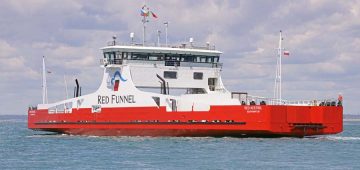
Red Kestrel
A review of 24 years of P & O's Cruise Ship Oriana
Related articles

Rotterdam Lloyd Inter-War Liners

The Malmo Class

The Ausonia of 1921

- Privacy Overview
- Strictly Necessary Cookies
- 3rd Party Cookies
This website uses cookies so that we can provide you with the best user experience possible. Cookie information is stored in your browser and performs functions such as recognising you when you return to our website and helping our team to understand which sections of the website you find most interesting and useful.
Strictly Necessary Cookie should be enabled at all times so that we can save your preferences for cookie settings.
These cookies enable extended functionality on our websites which allow you to sign up for, and manage your account with Warships IFR as well as save your cookie preferences.
These cookies are not loaded onto your machine until you a) create an account with us, or b) engage with this cookie banner to make your preferences known.
If you disable this cookie, we will not be able to save your preferences. This means that every time you visit this website you will need to enable or disable cookies again.
This website uses Google Analytics to collect anonymous information such as the number of visitors to the site, and the most popular pages.
Google analytics cookies have a maximum lifetime of 2 years on your machine.
Keeping this cookie enabled helps us to improve our website.
Please enable Strictly Necessary Cookies first so that we can save your preferences!

Oriana Closes Out P&O Cruises Career
- August 11, 2019
After a 24-year career with P&O Cruises UK, the Oriana is now heading to new owners in China and completed her final sailing for P&O on August 9 when she returned to Southampton.
The 1,822-guest ship will be renamed the Piano Land and is expected to start operations from Xiamen, China, later this year.
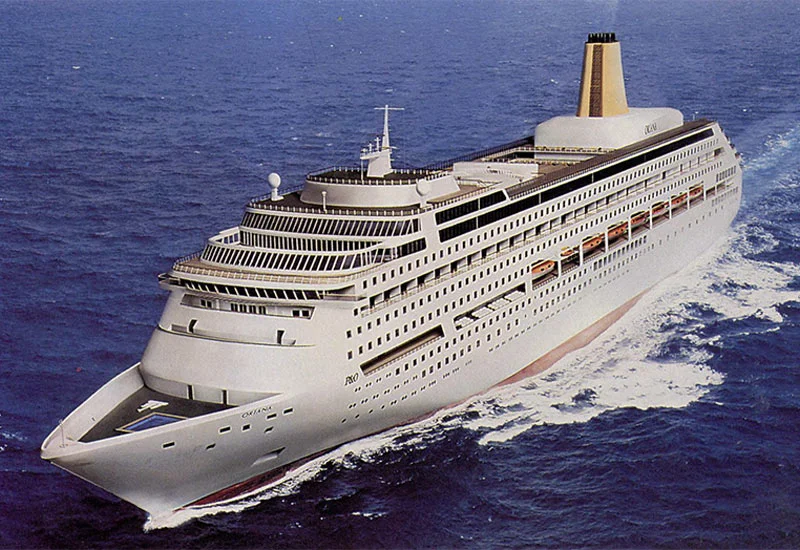
A ceremony was held aboard during the Oriana’a final sailing as her first captain, Ian Gibb, was aboard to discuss his career and the Oriana.
Her final sailing happened under the command of Captain Sarah Bretton, who, along with P&O President Paul Ludlow, presented Gibb with a sword that he originally accepted during the ship’s April 1995 naming by Queen Elizabeth II and had remained aboard since.
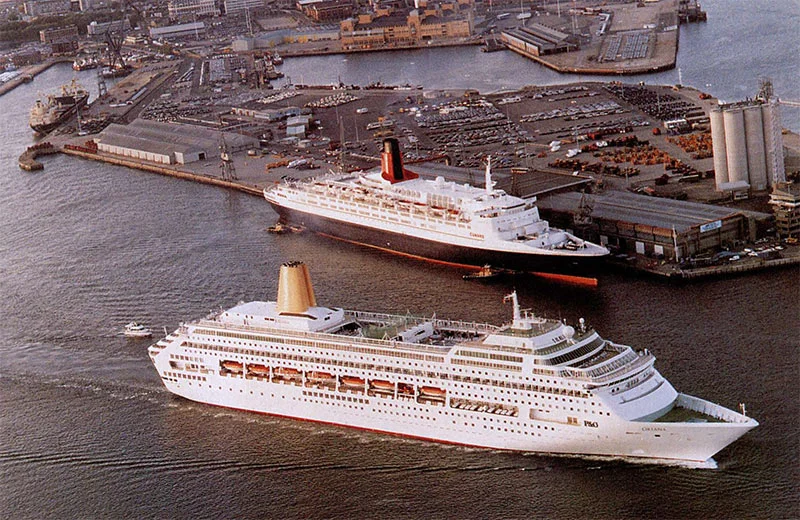
The ship launched in 1995 and was built at Meyer Werft at a cost of 200 million pounds.
She had the largest swimming pool at sea when she debuted in Northern Europe and the Mediterranean in 1995.

In addition, she had the most outdoor deck area and the largest stabilizers ever fitted to a cruise ship.
Her inaugural 1995 deployment was made up 17 cruises, ranging from 12 to 23 nights, followed by a 90-night world voyage that departed in January 1996, that included 28 ports and 24 maiden calls for P&O.
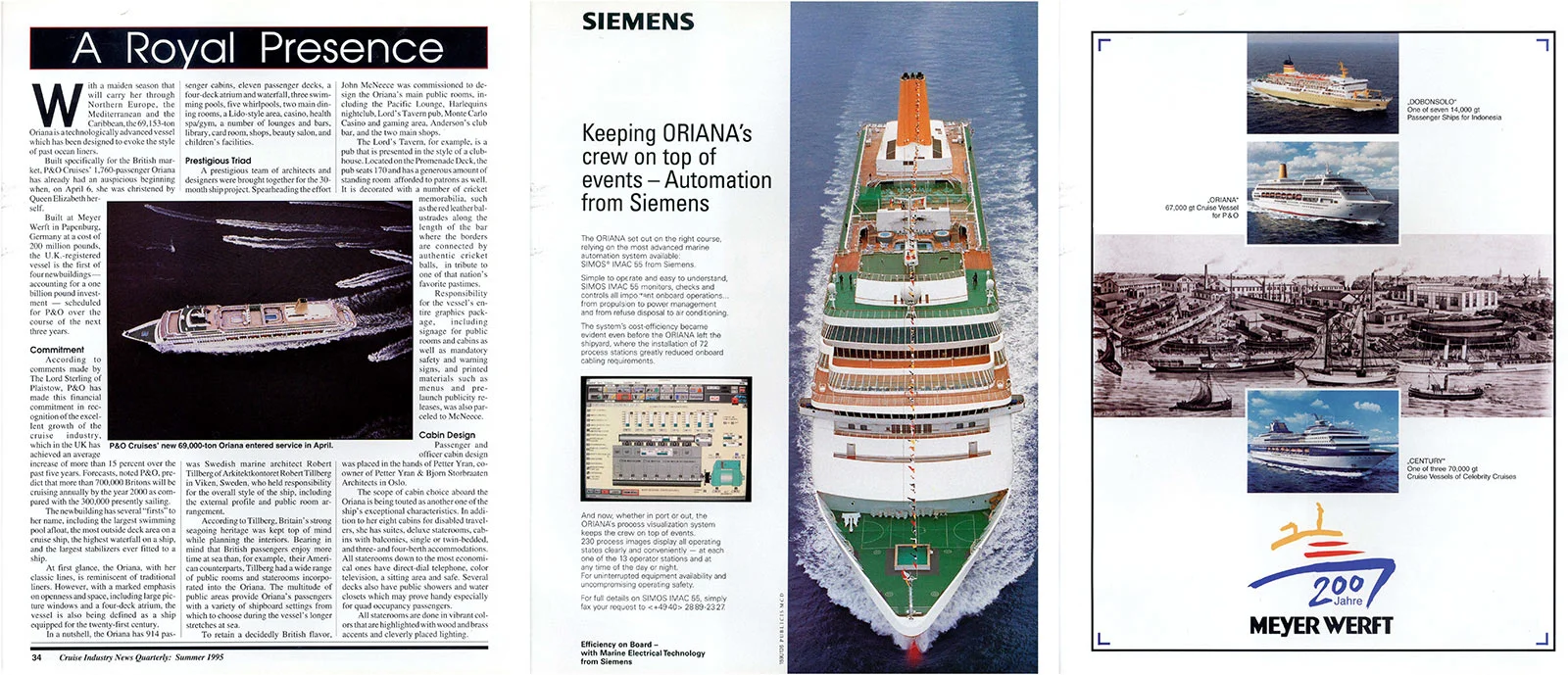
Built with a cruising speed of 24 knots, she was said to be the fastest cruise ship built in the last 25 years when she debuted in 1995.
Cruise Industry News Email Alerts
- Breaking News
Get the latest breaking cruise news . Sign up.
54 Ships | 122,002 Berths | $36 Billion | View
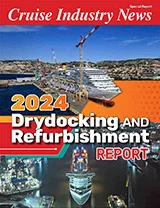
Highlights:
- Mkt. Overview
- Record Year
- Refit Schedule
- PDF Download
- Order Today

- 2033 Industry Outlook
- All Operators
- Easy to Use
- Pre-Order Offer
- Advertising
- Cruise News
- Magazine Articles
- Quarterly Magazine
- Annual Report
- Email Newsletter
- Executive Guide
- Digital Reports
Privacy Overview

One of the smaller and older ships in P&O’s fleet, Oriana was launched in 1995 and totally refurbished in 2016. The large resort-style ship is for adults only and attracts mature cruisers. Oriana combines comfort with classic features such as teak decks, a tiered stern and a stunning atrium with a Tiffany glass ceiling. The 69,153 tonne ship can accommodate 1,870 passengers and 760 crew.
[fa type=”bed”] Accommodation
Oriana has 941 cabins with five different categories. The largest are Suites which are 415 square feet. There are eight cabins and two inside single cabins with wheelchair access. All cabins are spacious and well-appointed with ensuite bathrooms. Superior cabins have larger bathrooms with separate baths.
[fa type=”cutlery”] Food
Oriana has six dining venues and seven bars. The main restaurants are Peninsular and Oriental, which offer the choice of Club Dining (same table at the same time each evening) or Freedom Dining (no fixed seating or times). Other options include Marco Pierre White’s Ocean Grill, which offers dishes preferred by British cruisers (cheese souffle, Thai fishcakes, grilled lobster and boar burgers) and Sorrento, which serves Italian pizza, seafood and pasta.
[fa type=”ticket”] Activities
Oriana has a large Oasis Spa, offering the latest alternative therapies and treatments, and a gym with high-tech muscle-toning machines. There is a unisex sauna, steam room, aerobics room, several massage and body treatment rooms and hot tubs for relaxation. For dance enthusiasts, there are four dance floors and professional dancers who act as dance hosts and teachers.
[fa type=”group”] Families
Oriana is an adults-only cruise ship. There are no facilities for children.
– Cruise Passenger
– Cruise Critic
Overall the ship appeared to be well run and maintained. My wife and I were a little surprised by this as the ship was due to go into dock in a month or so for a major refit, yet apart from some rather worn areas of carpet the ship looked to be in excellent condition. We have been on many ships which were not due for refurbishment, but were in a much worse condition than the Oriana. We have already booked another Oriana cruise. – Deck Cargo
– Berlitz
Find an expert review on the ship
Search our reviews for a feature review from our experts.
Find a review here
Have you cruised on this ship.
Leave a review for your fellow travellers and win champagne.
Leave a review here

Passenger Reviews
Related posts.
Find out all you need to know from our professional Cruise Passenger team
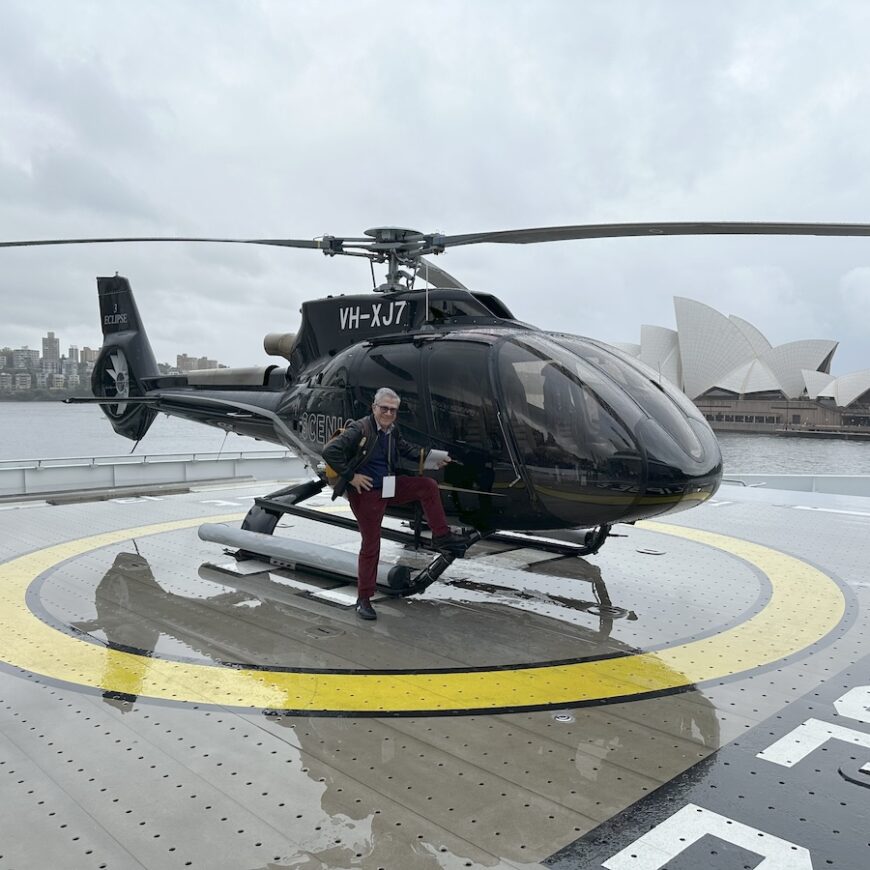
Scenic Eclipse II: champagne, heli-fishing and the next big thing

Ponant uses AI to design first carbon neutral sailing ship

Resilient Lady’s popularity means Virgin Voyages returns next year
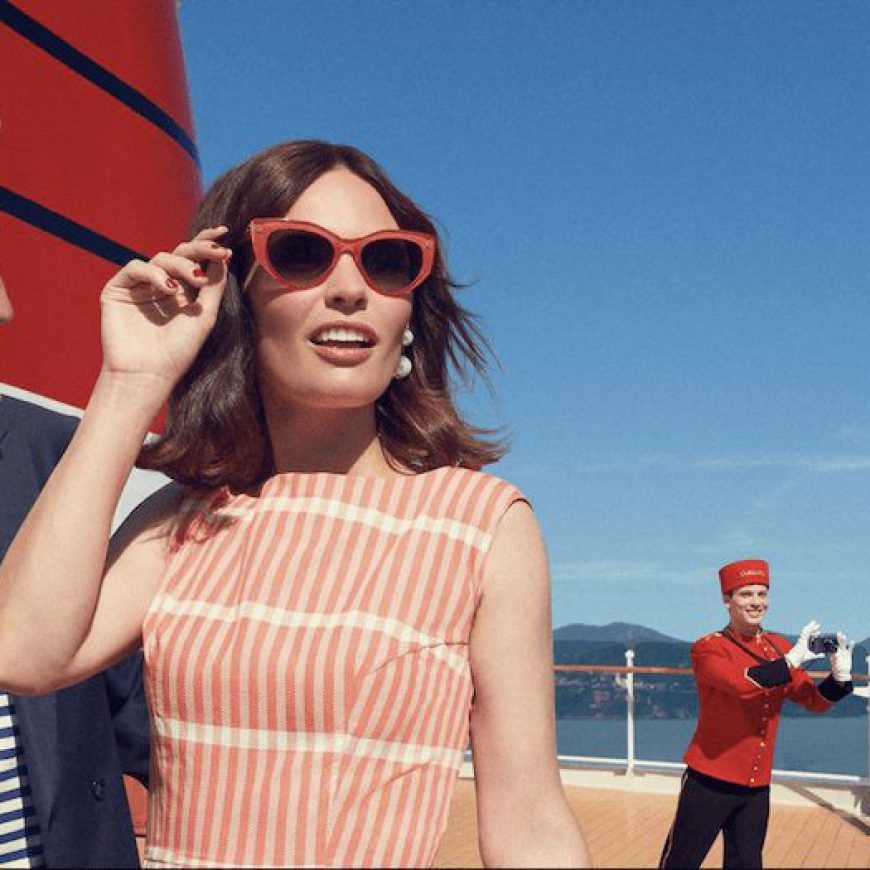
Cunard reveals 195 new voyages including cruises on the new Queen Anne
8 things you need to know about Royal Caribbean’s Icon of the Seas
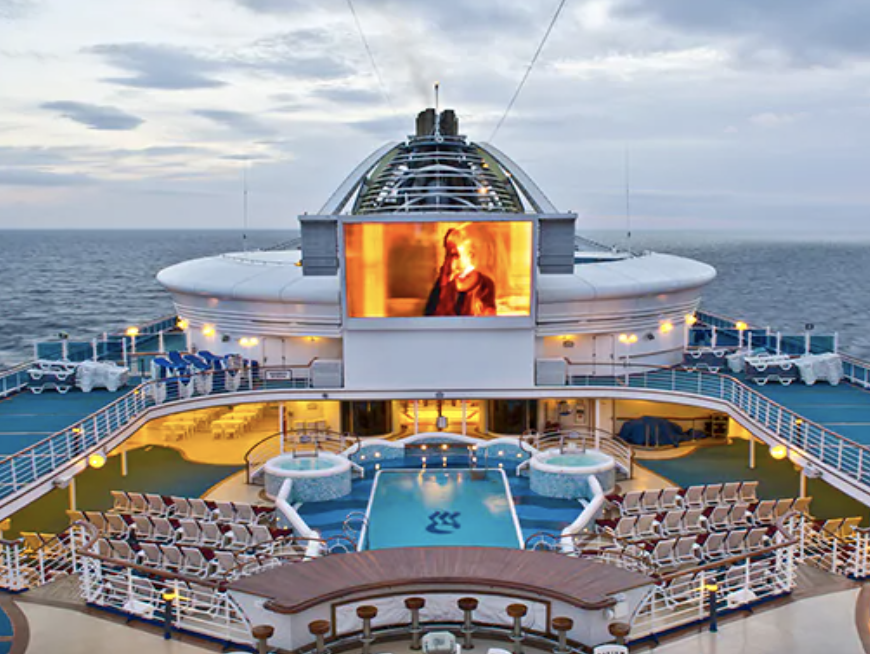
8 things to know about the Grand Princess
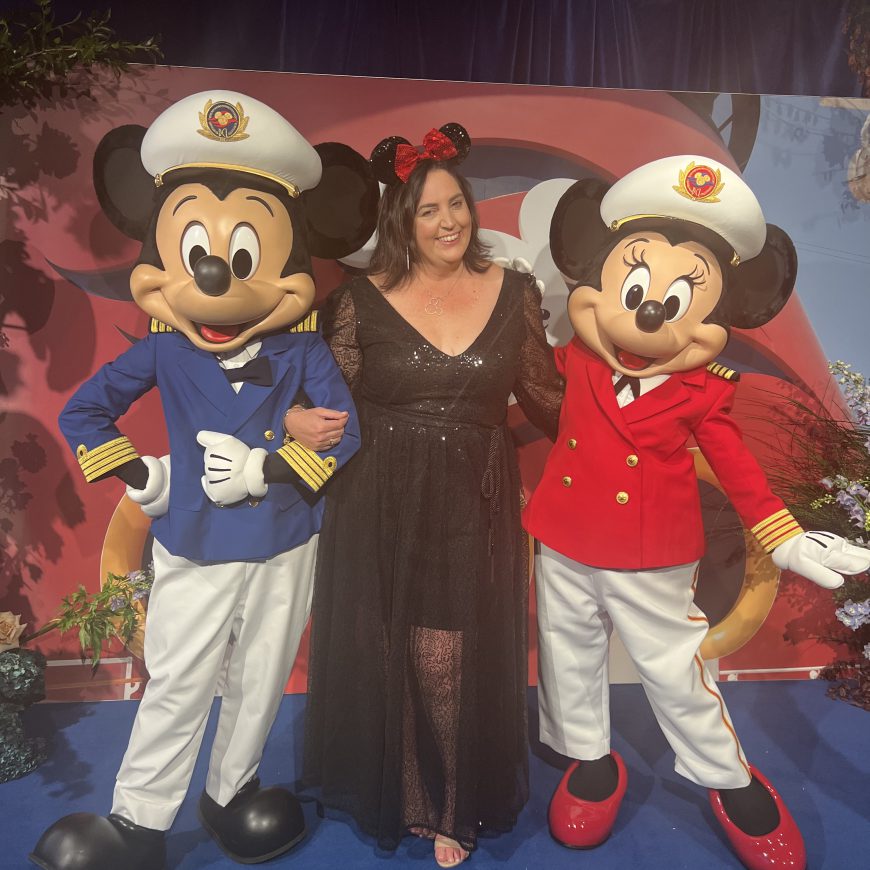
How this mum of six booked 100 cabins for Disney’s inaugural Australian season
Latest images of the sun princess’ interior revealed.
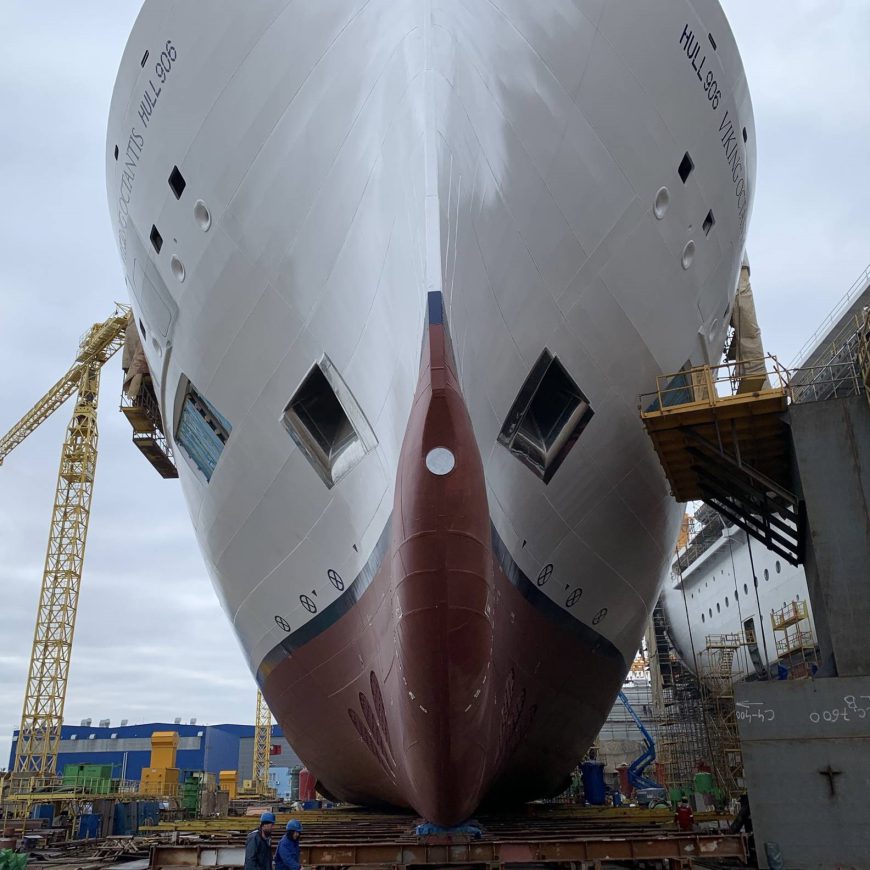
Viking orders four new “green” ocean going ships with Italian Fincantieri shipbuilder

Coral Princess is the first cruise ship to return to Melbourne
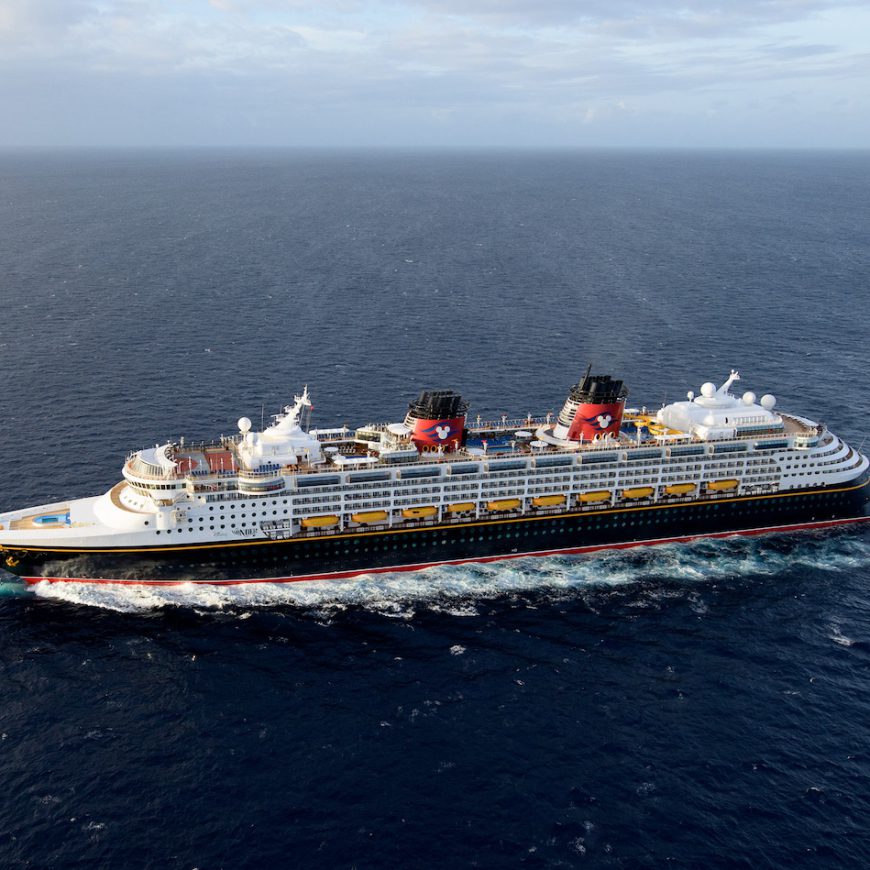
Disney Cruise Line to sail Australia, sparking a battle for your cruising kids
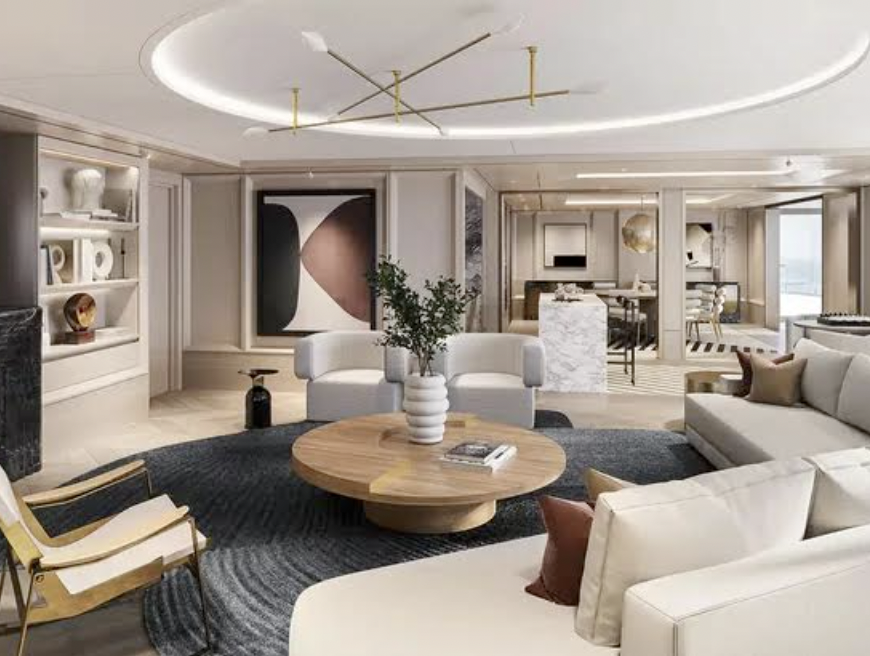
Discover the art of cruising with Regent Seven Seas
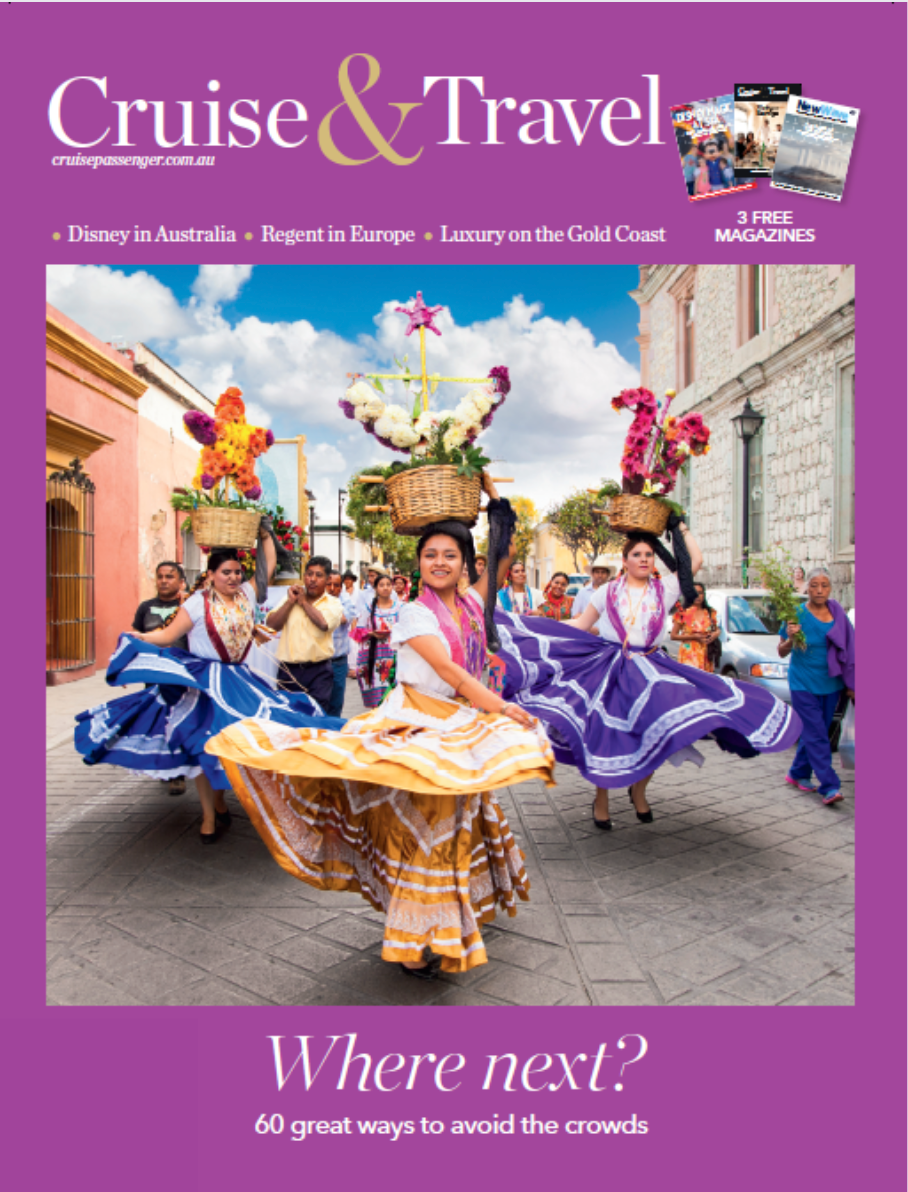
Cruise&Travel magazine is Australia’s No.1 publication for travel enthusiasts.
There are four issues per year, with each issue is packed full of must-read features, including cruise news, reviews, destination guides and the most enticing itineraries.
- Tips & Advice
- &Travel
- Cruise Planner
- Privacy Policy

Oriana Ship Info
- Deck 7 Prom
- Deck 12 Lido
- Deck 13 Sun
- Click here for ALL
- Deluxe Balcony
- Ship info and tracking
- Cabin Check
On this page you will find Oriana features, history, sister ships, and useful facts provided by Cruisedeckplans.com.
PO UK Cruise Line
General information.
The Oriana started sailing in 1995. Former names: none. The Oriana is registered in Hamilton, Bermuda. The Oriana has 941 cabins. You can expect between 1882 to 1882 passengers on a typical sailing. This means that at the higher number (usually peak and holiday sailings) Oriana has a space ratio of 36.7. (A space ratio less than 33 means that you may find the ship crowded in areas. A space ratio greater than 39 means that there should be plenty of space for each passenger.) When this ship isn't sailing at capacity the space ratio can be as good as 36.7. The Oriana has 800 crew members on board. There are 2 passengers for every crew member on board. There are self serve laudromats on this ship.
Sister Ships
The following ships share the same class as this ship. This means the basic design and layout of the ship is the same. For the most part the cabins will be identical among these ships, but may be decorated differently. 1995- Oriana - No longer sailing 2000- Aurora
Accessibility
There are 8 special needs cabins on this ship. These cabins have been modified for accessibility purposes.
13 Decks
There are 13 on this ship. The highest deck number is 13. The number of decks with passenger cabins is 6.
14% Balconies
This is the percent of the staterooms on board have balconies.
Other Information
With her signature tiered stern decks, Oriana is elegant and attractive. She has been specifically designed to suit British tastes; the broad teak promenade and lido decks are great for sun bathing and watching the world go by; the card room and wood panelled library are ideal for relaxing in, as are the bars including the Lord's Tavern sports bar and the iconic Anderson's bar. Oriana's signature features are a stunning atrium with a Tiffany glass ceiling, a panoramic Crow's Nest bar and Marco Pierre White's Ocean Grill restaurant situated in the sumptuous surroundings of the Curzon Room. In addition to Ocean Grill, Oriana boasts other fabulous restaurants, including Sorrento, an Italian restaurant, and the Mediterranean styled Al Fresco. She also has a theatre, cinema, show lounge, nightclub and casino to ensure that entertainment is always within easy reach.
Oriana Ship Stats
Oriana features.
- 5 Whirlpools (hot tubs)
- No Rock Climbing Wall
- No Flow Rider
- No Ice Rink
- No Waterslide
- No Water Park
- No Ropes Course
- No Mini Golf
- Sports Court
- No Jogging Track
- No Cigar Lounge
- Show Lounge
- Fitness Center
- No Bridge Viewing Area
- No Outdoor Movie Screen
- Teen Lounge
- No Passenger Promenade
- Sea Viewing Lounge on upper deck
- No Adult Only Outside Lounge Area
Smoking Policy
- Smoking is not permitted in any public room, inside your cabin, or on your cabin balcony
- Electronic cigarettes which do not emit smoke/vapor are not permitted in public areas but can be used in staterooms, balconies, and designated areas of the open deck
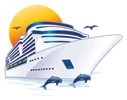
CRUISEDECKPLANS.COM Use the input buttons above to go to the main page for a Cruise Ship or Cruise Line.
Protect Your Trip »
Here's when you need (and don't need) a passport to cruise.
It's the type of sailing – closed-loop or open-loop – that largely determines whether or not you need a passport to cruise.
Do You Need a Passport for a Cruise?

Getty Images
A passport isn't always required for cruising.
To determine whether or not you need a passport to cruise, you first need to figure out if the itinerary is closed-loop or open-loop (also known as open-jaw).
Closed-loop cruise: A closed-loop cruise typically doesn't require a passport since it begins and ends in the same U.S. port (though there are some exceptions to this rule).
Example: Royal Caribbean International 's seven-night Western Caribbean & Perfect Day cruise stops in several countries – the Bahamas, Jamaica, Haiti and Grand Cayman – but the itinerary is considered closed-loop because it starts and ends in Fort Lauderdale, Florida.
Open-loop cruise: An open-loop cruise begins in one U.S. port and ends in a different U.S. port.
Example: Carnival Cruise Line 's 16-day Panama Canal from Seattle itinerary is not considered closed-loop because it departs from Seattle and completes its journey in New Orleans.
All of the above regulations have been determined by the Western Hemisphere Travel Initiative: a plan by the departments of State and Homeland Security that determines which documents are acceptable for proving identity and citizenship when entering the United States.
Where to cruise without a passport
There are several destinations where you can cruise without a passport on a closed-loop sailing. They include the following:
- The Bahamas
When looking at cruises to these locations, be mindful of the home ports. The Bahamas, Mexico, Bermuda, the Caribbean and Canada are all foreign ports, which means they only qualify for the passport exception if they are a stop along your cruise itinerary . If the cruise originates in any of these countries, it is likely you will need a passport.
Since Alaska, Hawaii and New England are all U.S. destinations, any closed-loop routes departing from these locations will not require a passport. However, keep in mind that it can be hard to find closed-loop cruises originating in Hawaii or Alaska.
To find closed-loop itineraries for a Hawaiian voyage or Alaskan cruise , try searching for sailings departing from major cities on the West Coast, like Seattle or Los Angeles . By contrast, quite a few closed-loop cruises leave from New England ports, but they are often marketed as Canadian cruises.
Tips on Trips and Expert Picks Newsletter
Travel tips, vacation ideas and more to make your next vacation stellar.
Sign up to receive the latest updates from U.S News & World Report and our trusted partners and sponsors. By clicking submit, you are agreeing to our Terms and Conditions & Privacy Policy .
When you need a passport for closed-loop cruises
Some cruise itineraries include foreign ports that require a passport for disembarkation. This is most commonly an issue for travelers on a closed-loop Caribbean cruise. Barbados , Guadeloupe , Haiti, Martinique , St. Barts , and Trinidad and Tobago all require U.S. citizens to present a valid passport to disembark and enter the country, despite WHTI regulations not requiring a passport for these destinations. Labadee, Royal Caribbean's private island , is an exception and does not require a passport despite its location in Haiti.
If your itinerary includes a country requiring a U.S. passport, your cruise line will require you to have the passport at check-in. Note that your passport must not expire within six months of your arrival in a foreign country or else it won't be considered valid for international travel.
Read: The Easiest Way to Renew Your Passport
Acceptable forms of ID
All travelers – U.S. citizens and foreign nationals alike – must present documents that show identity and citizenship when entering the United States. A U.S. passport can show both. If you don't have one or don't want to bring one, be aware that you may need to present more than one document.
U.S. citizens 16 and older
If you're a U.S. citizen age 16 or older sailing on a closed-loop cruise without your passport, you will need a government-issued photo ID like a driver's license. In addition, you must present a document that proves your U.S. citizenship. These include:
- Passport card
- State-issued enhanced driver's license (EDL)
- Government-issued birth certificate
- Trusted Traveler Program card (NEXUS, SENTRI or FAST)
- American Indian Card (Form I-872) or Enhanced Tribal ID Card
The Trusted Traveler Programs are risk-based programs to facilitate the entry of travelers who have been vetted and preapproved. Most of these programs will provide you with a machine-readable card that allows you to pass through border checkpoints quickly. Keep in mind, some of these IDs are only available to travelers 16 and older.
Read: TSA Precheck vs. Global Entry
U.S. citizens younger than 16
U.S. citizens younger than 16 are only required to present proof of citizenship, such as one of the following documents:
- Original, notarized or certified copy of their government-issued birth certificate
- Consular Report of Birth Abroad issued by U.S. Department of State
- Certificate of Naturalization issued by U.S. Citizenship and Immigration Services
Read: How to Get a Passport for Kids
Non-U.S. citizens
If you are a lawful permanent resident (or LPR) of the United States, you are required to present a permanent resident card or other valid evidence of permanent residence status.
Non-U.S. citizens, with the exception of Canadians and Mexicans, are not subject to passport exceptions, so a valid passport will need to be provided. Canadian citizens can present a valid passport, Enhanced Driver's License or Trusted Traveler Program card. Mexican citizens must present a passport with a visa or a Border Crossing Card.
Unacceptable forms of ID
While most common forms of identification are accepted, there are a few exceptions. U.S. military identification cards and U.S. Merchant Mariner documents are valid forms of identification, but only when traveling on official orders or in conjunction with official maritime business, so it is unlikely they will be accepted when traveling on a cruise.
Here are some other documents that will not be accepted as proof of citizenship:
- Voter registration cards
- Social Security cards
- Baptismal papers
- Hospital certificates of birth (for anyone older than a newborn)
It is important to note that many of the permitted forms of identification, such as a passport card or EDL, are only accepted at land and sea border crossings. Unforeseen circumstances, such as a medical air evacuation, may cause you to return to the U.S. by air travel. In this case, these documents won't be accepted when you try to reenter at the border crossing.
To avoid extra delays in your return to the U.S. following unforeseen travel complications, the Department of State recommends that everyone taking a cruise from the United States carry a valid passport book in case of emergency.
Why Trust U.S. News Travel
Erin Vasta has traveled extensively to international destinations, gaining a deep knowledge of travel regulations in the process. Her expertise in this area has saved her family and friends from unnecessary travel delays and ensured stress-free trips through border security in nearly 15 countries. To write this article, Vasta used her international travel experience and research skills.
You might also be interested in:
- The Top Passport Holders
- Cruise Packing List: Essentials to Bring
- Safe at Sea: The Best Cruise Insurance
Tags: Travel , Travel Tips
World's Best Places To Visit
- # 1 South Island, New Zealand
- # 4 Bora Bora
If you make a purchase from our site, we may earn a commission. This does not affect the quality or independence of our editorial content.
You May Also Like
12 cheap fourth of july getaways.
April 29, 2024

The Best Tours of Buckingham Palace
Laura French April 29, 2024

Flight Canceled or Delayed? What to Do
Amanda Norcross April 26, 2024

The Best Beach Hats
Megan Johnson and Sharael Kolberg April 26, 2024

The Best Florence Tours
John Rodwan April 25, 2024

The 9 Best Louisiana Swamp Tours of 2024
John Rodwan April 24, 2024

How Much Does a Cruise Cost?
Gwen Pratesi April 24, 2024

The Best Whale Watching in Cape Cod
Lyn Mettler April 24, 2024

Best Whale Watching Tours in Maine
Marisa Méndez April 23, 2024

The Best Wineries in Napa Valley
April 23, 2024


Why Some Smart Cruise Travelers Stay on the Ship During Port Days
W HEN SUSAN HARSELL, a travel adviser based in Basye, Va., arrives at a port during a cruise vacation, she runs through a mental checklist to decide whether she wants to get off the ship or not. She evaluates her ship’s arrival time (afternoon arrivals are less crowded than mornings), length of stay and the number and size of other ships already at port. Only when she’s confident she’ll have a rewarding, immersive visit ashore does she get off the ship.
Every cruise port call triggers this dilemma and few of us can weigh the options as professionally as Harsell can. Staying on deck can bring on unbearable levels of FOMO, but if you disembark with little sense of what you’re in for, you might end up packed into a tour bus, wishing you were on your third margarita on the ship’s deck instead. To make the most out of days off the ship—and to know when to stay put—it helps to do some leg work.
Know Your Ports
On “port days,” when the ship is docked, cruisers step out of the bubble of a cruise ship and stretch their legs. Some travelers view those days—and the ability to pop into multiple places—as the whole point of the trip.
But in certain ports, your ship might pull into a spot next to six other mega liners. The best strategy in these cases: Skip group activities and opt for an in-and-out approach. “Get off early, knock out what you want to do and then get back on the ship,” advised Doug Parker, host of Cruise Radio, a podcast about cruises.
Before Barry Maher, a motivational speaker based in Santa Barbara, Calif., steps foot on any ship, he studies its port stops. “I know which ones I want to hit,” he said, “and decide how I want to hit them,” whether on his own or as part of a ship tour.
If you value immersing yourself in a destination, or dislike traveling long distances on shore visits, think small. Smaller lines like Windstar Cruises and the Ritz-Carlton Yacht Collection can dock at less-crowded ports closer to the action. In Bermuda, big ships pull into the Royal Navy Dockyard, but a dock on Front Street in Hamilton caters to smaller ships and obviates the need for bus rides.
At the cruise terminal in Vancouver, you’re just steps from key attractions, like the Vancouver Lookout, which offers 360 views of downtown. In St. Maarten, you might have to travel a bit to get to Maho Beach, where planes buzz right overhead as they land, but for planespotters, it’s a no-brainer.
Think in terms of the value proposition, says Parker. Look at cost, personal interest, transit time and activity time. He might pass on, say, a crowded in-and-out tour, but happily take a break from the sun deck and hop into a bus for a new experience like learning to play Gaelic football in Cork, Ireland.
Know Yourself
Before you go ashore, get real about your fitness level. Port days can mean a lot of walking, especially in the Mediterranean, a region known for hot sun and long shore visits. Harsell advises her clients “to find whatever balance is right for them.” Most cruise concierges will happily provide a rundown of the terrain well in advance.
Cruisers with limited mobility, for instance, might not welcome the uneven cobblestone streets in Santorini. And a “tender port,” where you must take a small boat to go ashore, can prove challenging.
It’s not always clear when booking if a port is docked or tendered, so “I always call the cruise line during the booking process,” said Cory Lee, a wheelchair-travel expert who shares his experiences on his website, Curb Free with Cory Lee. Lee likes newer ships, like Virgin Voyages’ fleet, which offer greater accessibility.
If you’re the independent type who likes to skip the group tour and go out on your own, it’s up to you to make your way back to the ship on time. Synchronize your watch with the ship’s time, then set your phone to Airplane Mode, advised Parker. The local time might differ from the ship time or you might cross time zones on an excursion. Both make it too easy to miss the ship at day’s end.
Skip the Lines
If you’re strategic, port days can double as spa days. When you know you’re in for an underwhelming shore experience, stay on board and get pampered instead—and enjoy a discount to boot, typically at least 20% off on major cruise lines like Celebrity and Crystal Cruises when on-ship spa demand is low.
On sea days, the lines for ship amenities can be maddening, especially for in-demand activities, like roller coasters and waterslides. Knowing in advance which shore days you’ll skip can eliminate anxiety about missing out on those attractions. You can just give them a whirl when everyone else is loading into the tour bus.


IMAGES
VIDEO
COMMENTS
SS Oriana was the last of the Orient Steam Navigation Company's ocean liners.She was built at Vickers-Armstrongs, Barrow-in-Furness, Cumbria, England and launched on 3 November 1959 by Princess Alexandra. Oriana first appeared as an Orient Line ship, with a corn-coloured hull, until 1966, when that company was fully absorbed into the P&O group. Faced with unprofitable around-the-world ...
With the Oriana having already served as a part time cruise ship, in 1973 P&O announced that she would now become a full time cruise ship. At first, she remained a two-class ship, however, in 1974, P&O decided that the class barrier would be dropped and the Oriana would become, like other P&O ships a one-class cruise ship.
After serving as a part time cruise ship for a while, in 1973 P&O announced that the Oriana would become a full time cruise ship. At first, she remained a two-class ship, however, in 1974, the class barrier was dropped, and Oriana, like other P&O ships, became a one-class ship carrying 1,677 passengers.
Oriana in such a way as to make evident this was a veiled compliment to Queen Elizabeth I, and the two Elizabeths were symbolised by the double E monogram of Oriana's badge. 22.11.1960: Maiden voyage was a five-day shakedown cruise Southampton/ Lisbon and back for Association of British Travel Agents convention members.
Oriana (1960 - 2005) P&O Cruises. Oriana 41915 GRT, loa 245m, 1700 passengers. Ordered in 1959 by British Orient Lines, she was the fastest ship on the Australian run. In 1965 Orient Lines merged with P&O Lines and she became a fleetmate of Canberra (see above). During the latter part of her career, she was used as a cruise ship, based in the ...
The Paul Oliver Story. Ex Oriana crewmember, Paul Oliver has spent years on the Oriana, and he has kindly provided us with his story. Earlier, Paul sent us an excellent series of photographs of Oriana berthed at Pyrmont which were taken by his ex P&O crew member & friend Colin Pursehouse, which shows a lonely ship awaiting her departure for ...
Image courtesy of P&O Cruises. Oriana is the first cruise ship commissioned for P&O Cruises. Built by Meyer Werft, the vessel entered service in April 1995 as the first cruise ship designed for the British cruise market. Oriana was constructed at Meyer Werft's shipyard located in Papenburg, Germany. It was launched in June 1994.
ss Oriana (1960) - Orient Line. admin23. June 23, 2023. In 1957 Orient Line (short for Orient Steam Navigation Company) ordered a new flagship, their largest yet. Like more passenger ships built at the time, she was designed with both liner service and cruising in mind. Her building price was 14 million pounds.
When she entered service Oriana was one of the largest cruise ships in the world, and also the largest ship built in Germany since 1914. Since then tonnages have boomed as the economies of scale dictate that a larger ships generates more profit. Nowadays most new cruise ships have a GRT of around 100,000 tonnes or higher.
Oriana was delivered to P&O Cruises in 1995, measuring 260 metres in length and featuring 914 staterooms - it was the largest passenger ship that had ever been built in Germany. The cruise liner was the predecessor of Aurora, which MEYER WERFT delivered to P&O Cruises in 2000. Oriana's theatre extends over three decks, featuring an ...
MV Oriana is owned and operated by P&O Cruises and entered service in 1995 when she was named by the Queen at the port of Southampton. At time of launch in 1995, she was one of the largest cruise ships in the world. MV Oriana is the fastest ship in the P&O fleet. She sails on an annual world cruise and spends rest of time cruising the ...
Cruise Ship Oriana. Oriana docking at Killybegs, Ireland. Ship Data. Cruise line: Double occupancy/max occupancy: 1818 / 1928 Crew: 800 Year built: 1995 Tonnage: 69000 Length overall: 856ft (261m) Beam: 105ft (32.2m) Draught: 27ft (8.2m) Cruising speed: 24 knots Flag: Bermuda
Oriana. Exclusively for adults, the Oriana prides it itself on its luxurious accommodations and options. Signature ship features include a Tiffany glass ceiling in the Atrium and the panoramic Crow's Nest. Attend the black tie soireé as the sun sets over the sea or relax on the poolside sun deck. Webcam and tracking link.
The Oriana is a popular cruise ship owned by the P&O Cruises company that has been sailing since 1995. It has been a beloved part of the P&O fleet for over two decades, and was last seen in port in the United Kingdom. The Oriana has had many different ports of call, including some of the most exciting cities and locations around the world.
Starting in 1948, Orient Line put three new 28,000-ton ships into service over a period of six years. The Orcades came first, followed by Oronsay in 1951 and the trio was completed with the Orsova in 1954. These ships were clearly built for the post-war world, since their passenger accommodation was divided into two classes only; First and Tourist.
Oriana was the most traditional of the fleet of large megacruise ships owned by P. & O. Cruises, and carried 1,828 passengers on several hundred long and short cruises after she was specifically designed and purpose built for the U. K. cruise market. Robert Tillberg of Sweden and John McNeece of the U.K. were the two main designers of Oriana ...
Oriana was traveling on an eastward round-the-world voyage from Southampton via Australia when it docked at Los Angeles in July 1965. Port of Los Angeles passenger terminal - Visitors waving goodbye. They had all been aboard ship during embarkation time for cocktails and parties given by passengers leaving from Los Angeles.
Oriana Closes Out P&O Cruises Career. August 11, 2019. After a 24-year career with P&O Cruises UK, the Oriana is now heading to new owners in China and completed her final sailing for P&O on August 9 when she returned to Southampton. The 1,822-guest ship will be renamed the Piano Land and is expected to start operations from Xiamen, China ...
Oriana combines comfort with classic features such as teak decks, a tiered stern and a stunning atrium with a Tiffany glass ceiling. The 69,153 tonne ship can accommodate 1,870 passengers and 760 crew. [fa type="bed"] Accommodation. Oriana has 941 cabins with five different categories. The largest are Suites which are 415 square feet.
MV Piano Land is a cruise ship in service for Astro Ocean, a newly-formed Chinese cruise line. She originally entered service in April 1995 as Oriana for P&O Cruises, and was named by Queen Elizabeth II. She was built by Meyer Werft at their shipyard in Papenburg, Germany, and measures 69,153 gross tons. As Oriana, she held the Golden Cockerel trophy in recognition of being the fastest ship in ...
The Oriana Turnaround When the cruise ship Oriana comes into port, it has just 12 hours to get everything ready for the 1,800 passengers on its next cruise. Chris Mersea joined the team for the day. It's 6.00 a.m., still dark, and above the rooftops of the port city of Southampton a large orange funnel appears. It's attached to the 69,000-tonne
(A space ratio less than 33 means that you may find the ship crowded in areas. A space ratio greater than 39 means that there should be plenty of space for each passenger.) When this ship isn't sailing at capacity the space ratio can be as good as 36.7. The Oriana has 800 crew members on board.
The Oriana turnaround When the cruise ship Oriana comes into port, it has just 12 hours to get everything ready for the 1 ,800 passengers on its next cruise. Chris Mersea joined the team for the day. It's 6.00 a.m., still dark, and above the rooftops of the port city of Southampton a large orange funnel suddenly appears. It's attached to the ...
Open-loop cruise: An open-loop cruise begins in one U.S. port and ends in a different U.S. port. Example: Carnival Cruise Line's 16-day Panama Canal from Seattle itinerary is not considered closed ...
WHEN SUSAN HARSELL, a travel adviser based in Basye, Va., arrives at a port during a cruise vacation, she runs through a mental checklist to decide whether she wants to get off the ship or not ...
On "port days," when the ship is docked, cruisers step out of the bubble of a cruise ship and stretch their legs. Some travelers view those days—and the ability to pop into multiple places ...